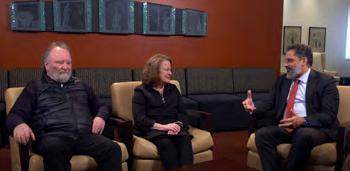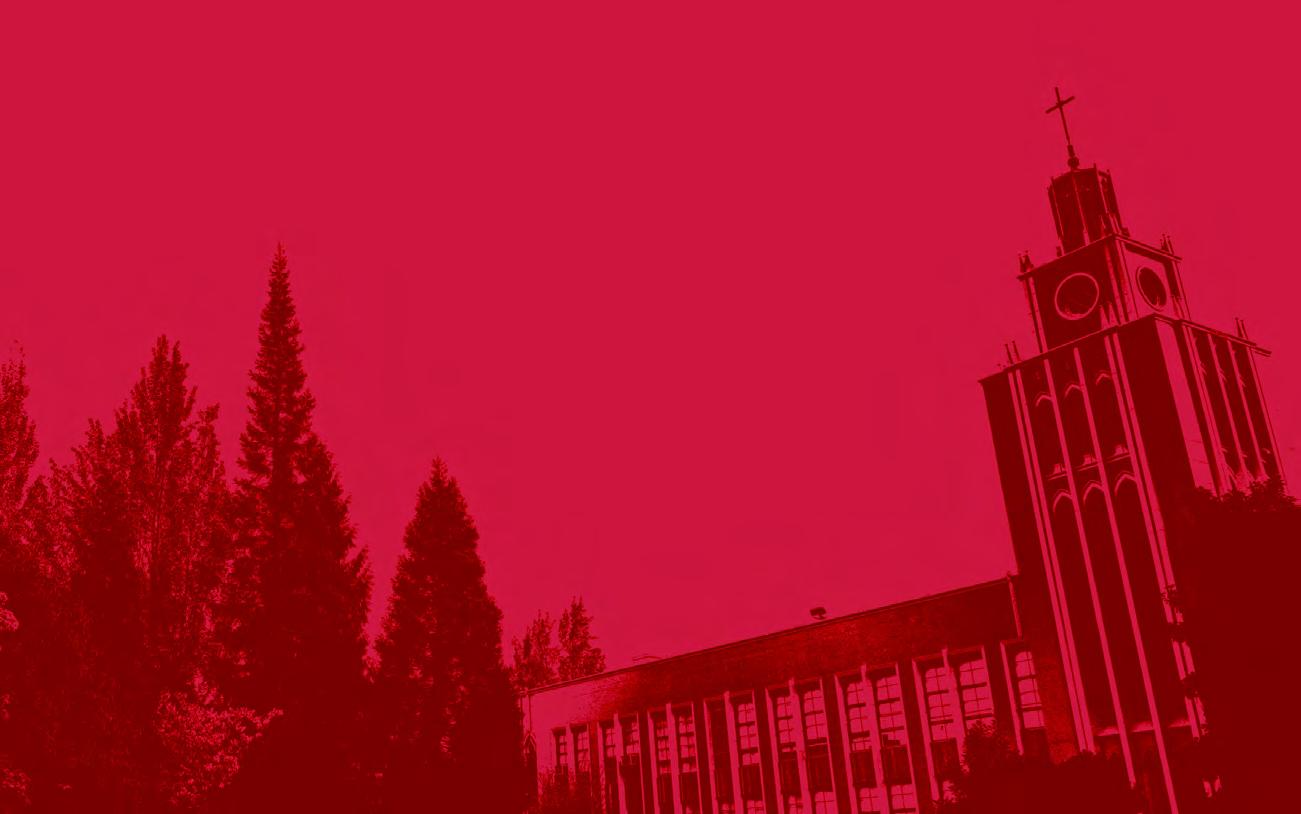Honoring the achievements and success of our remarkable alumni.



Honoring the achievements and success of our remarkable alumni.


Seattle University first-year student Fatema Juma of Bahrain enjoys her first-ever experience with snow as the city enjoyed an early season snowfall.

EDITOR
Tina Potterf
LEAD DESIGNER
Marissa Leitch
SENIOR WRITER
Andrew Binion
CONTRIBUTING WRITERS
Robin Lesh, Mike Thee
PRODUCTION MANAGER
Terry Lundmark, ’82
UNIVERSITY PHOTOGRAPHER
Yosef Kalinko
VICE PRESIDENT / UNIVERSITY AFFAIRS
Scott McClellan
EDITORIAL ADVISORY BOARD
Ellen Whitlock Baker, Julie Brady, Edgar Gonzalez, Shane P. Martin, Robin Meeks, Anne Moran, Eduardo Peñalver
Seattle University Magazine (ISSN: 1550-1523) is published twice a year by Marketing Communications, Seattle University, 901 12th Avenue, PO Box 222000, Seattle, WA 98122-1090. Periodical postage paid at Seattle, Wash. Distributed without charge to alumni and friends of Seattle University. USPS 487-780. Comments and questions about Seattle University Magazine may be addressed to the editor at 206- 296-6111; the address below; fax: 206-2966137; or e-mail: tinap@seattleu.edu. Postmaster: Send address changes to Seattle University Magazine, Marketing Communications, Seattle University, 901 12th Avenue, PO Box 222000, Seattle, WA 98122-1090. Check out the magazine online at www.seattleu.edu/newsroom/.
Seattle University does not discriminate on the basis of race, color, religion, sex, national origin, age, disability, marital status, sexual orientation, gender identity, political ideology or status as a Vietnam-era or special disabled veteran in the administration of any of its education policies, admission policies, scholarship and loan programs, athletics, and other school-administered policies and programs, or in its employment-related policies and practices. All university policies, practices and procedures are administered in a manner consistent with Seattle University’s Catholic and Jesuit identity and character. Inquiries relating to these policies may be referred to the university’s Assistant Vice President for Institutional Equity, Elizabeth (Liz) Trayner, etrayner@seattleu.edu.
on the cover
Alumna of the Year Dorothy Cordova, ‘53, is a true pioneer.
6 did you know
A compendium of news and happenings from around campus.
8 on campus
New endowment celebrates the life and legacy of D’Vonne Pickett Jr., ‘14.
10 on campus
After a storied career spanning more than five decades at Albers, Bill Weis will retire this June.
12 on campus
Sundborg Center for Community Engagement marks major milestone.
14 on campus
Transforming the professoriate.
16 faculty spotlight
Professor Jeanette Rodriguez, PhD, is answering Pope Francis’ call to action on the climate crisis.
18 alumni awards
This year’s honorees reflect the best in service, community engagement and athletic excellence.
34 alumni engagement
Make an impact through a gift to the SU Fund.
37 in memoriam & class notes
38 the last word
Acclaimed Seattle artists Dennis Evans and Nancy Mee are gifting Seattle University their considerable art collection.

Universities are not known for their comfort with change. And yet, we like to describe Seattle University as the place “where innovation meets humanity.” This is not just some empty slogan. For us, it reflects a distillation of our aspirations as a Jesuit university to bring the enduring values of the 500-year-old Ignatian educational tradition into the context of the global hub of technology that is Seattle. This latest issue of the Seattle University Magazine includes many examples of how we are living out that aspiration.
One example of our commitment to innovation is our exciting new partnership with T-Mobile. Not only is this collaboration enabling us to become a 5G campus, but it is also bringing one of our region’s most innovative companies to our students, providing them with opportunities to put their education into action.
Nothing is more relevant to the intersection of innovation and humanity than the vital conversations happening around new technologies, like generative artificial intelligence. Last spring, with the support of a gift from Microsoft, Seattle University hosted a conference on the ethical implications of AI, which featured leading thinkers from industry and the academy. Among those we were delighted to welcome to our campus was Pope Francis’s key advisor on technology issues, Father Paolo Benanti. This summer, Fr. Benanti—who was recently selected to lead the Italian government’s AI commission—will be joining us once again as a distinguished visiting professor.
Our commitment to innovation goes beyond technology. It includes new ways of measuring faculty excellence. Through the National Science Foundation’s Advance Grant, Seattle University is leading the way in reimagining the traditional standards for tenure and promotion to take into account a broader range of
activities, including categories of research and service work that have traditionally been undervalued in those processes. Seattle University’s efforts have become a model for higher education institutions across the country.
In this issue we also celebrate the achievements of our wonderful Alumni Award winners and the newest inductees into the Athletics Hall of Fame. Their stories uplift, inspire and speak to our “innovation and humanity.”
Finally, nothing illustrates the Jesuit commitment to innovation and humanity more than the integration of the arts into the educational experience of our students. A generous new gift of art by prominent Pacific Northwest artists Nancy Mee and Dennis Evans will enrich the lives of our students for generations to come. Evans and Mee are donating the bulk of their personal art collection, which includes a significant collection of Coast Salish art, to Seattle University, along with a financial commitment to support the curation of Northwest art on our campus.
You can read more about each of these stories in the pages that follow and online at The Newsroom. I hope you enjoy reading about the many ways we are living out our Jesuit educational mission in the rapidly changing context of the city we call home.

Seattle University partnership with T-Mobile will broaden innovative opportunities across campus.
Seattle University and T-Mobile have joined forces to help deliver Seattle University’s Connected Experience initiative, which aims to improve digital equity for students, advance student success outcomes, increase operational efficiencies and drive innovation. T-Mobile will be the primary 5G service provider for the campus-wide internet network as well as equipping the university’s staff with 5G-connected devices to streamline operations.
Seattle University will deploy several projects that leverage 5G such as:
• Building out high-speed internet across campus.
• Enhance campus safety and security services using 5G-enabled smart cameras.
• Increasing connectivity for international students.
• Student-led academic projects leveraging 5G innovation.
“The joint program will help us create a more collaborative and innovative campus for Seattle University students to learn,” President Eduardo Peñalver.
Read the full story
what they’re saying
“Throughout his 51 years of teaching, Bill Weis has had an extraordinary impact on our students. Although we have many amazing faculty, Bill is the former professor that students are most likely to mention. That is the most important part of his legacy—his transformational work with students.”
—Joseph Phillips, dean, Albers School of Business and Economics, on Professor Bill Weis, PhD, who has taught at the business school for more than 50 years.
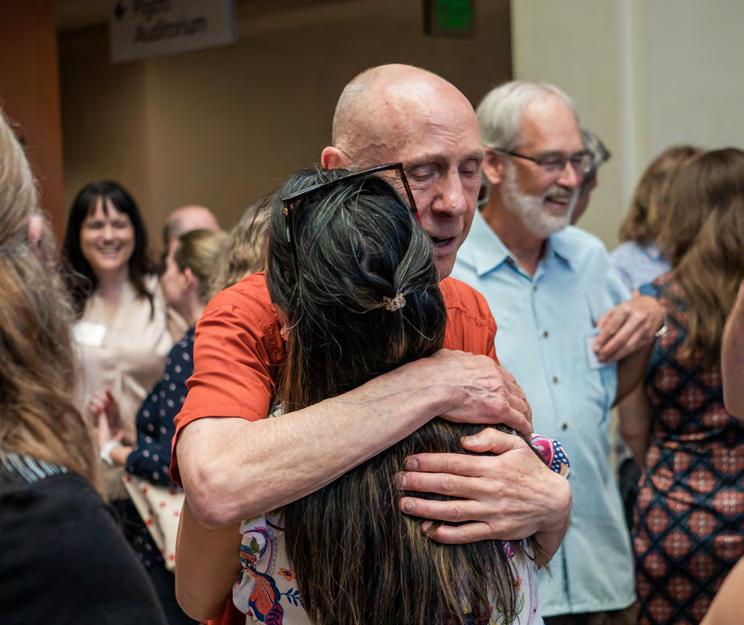
Read all about the remarkable teaching career of Albers Professor Bill Weis, PhD, on page 10
Read more about these stories and other SU news at

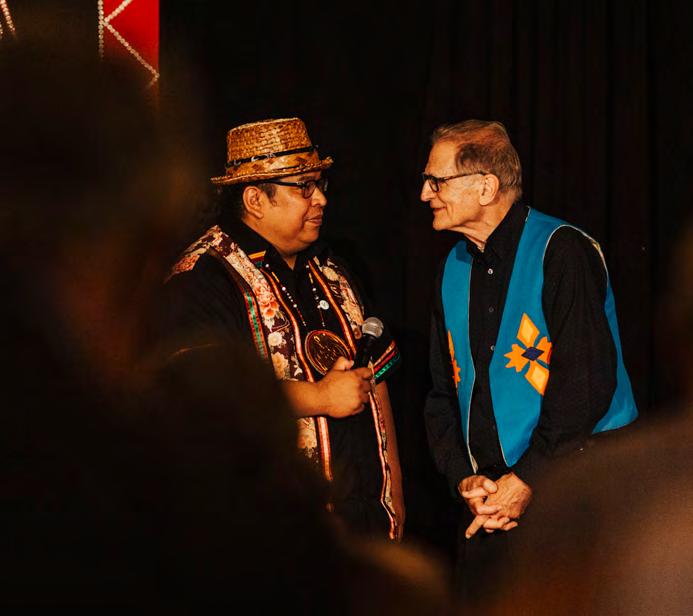
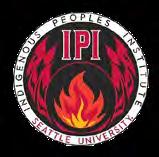
Patrick Twohy, S.J., has devoted a half century to living with and supporting the Native peoples of the Northwest. During these 50 years he has worked closely with many tribes, earning their trust and love for his tireless commitment to share their stories, struggles, loss and joy alongside them.
Fr. Twohy, after 20 years of working with and living among the Swinomish and Tulalip tribes, officially retired from his duties though his calling—and his legacy—to elevate the voices and stories of Native and Indigenous people continues on. From the outset it was clear to Fr. Twohy that his work with tribal communities was his vocation—he felt a pull that brought him onto their land and into their lives.
“It was a conviction, an inspiration that showed itself to me,” Fr. Twohy says. “As a Jesuit trainee I spent some summers on reservations. I had good experiences and didn’t feel the tragic pain of it all.
“There was probably a seed first planted there,” he continues. “I admired the priests that practiced there, helping people often pushed to the margins.”
While at SU he was instrumental in establishing the Indigenous Peoples Institute (IPI), which supports Native American student success and raises awareness about issues of critical importance to Indigenous peoples.
Want to support this work? Consider a gift to the Indigenous Peoples Institute Patrick Twohy, S.J. Endowment, which funds events, academic programs and Indigenous students at SU. Email Katie Chapman for more information: chapmank@seattleu.edu
Seattle University’s undergraduate population is getting more diverse— economically and ethnically—and pursuing more degrees within the College of Science and Engineering.
“Our Jesuit mission fosters an academic and social environment in which students from all backgrounds are welcomed and can be successful,” says James Miller, assistant provost and dean of admissions. “We believe that academic excellence requires a diverse student body and vice-a-versa.”
ethnically diverse population among fall quarter ftic students

underrepresented minority students
62% 28% up from 58 percent the previous year up from 26 percent the previous year
what they’re saying
“One of the great things about this gift is these pieces will be on the walls on all the buildings. Generations are going to look at them, learn from them. It’s a teaching tool as well as a safeguard of the art. And I consider this collection like our ancestors, our teachers, our students.”
—Artist
Dennis Evans on the art collection he and his wife, artist Nancy Mee, bequeathed to Seattle University along with a gift to create an arts-related endowment.
An endowment honoring late alumnus D’Vonne Pickett Jr. will bolster support for Black- and minority-owned businesses.
by andrew binionTo cement the legacy of D’Vonne Pickett Jr., ‘14, Seattle University has established an endowment in his name to ensure that future generations of Black- and minority-owned businesses benefit from the College of Science and Engineering’s Project Center.
In 2018, Pickett and his wife KeAnna Rose Pickett founded The Postman in Seattle’s Central District, a mail business located in the heart of Seattle’s historical Black community.
Prior to starting his business Pickett, who majored in communications, played for the men’s basketball team as a guard and for the London Lightning professional team in Ontario, Canada.
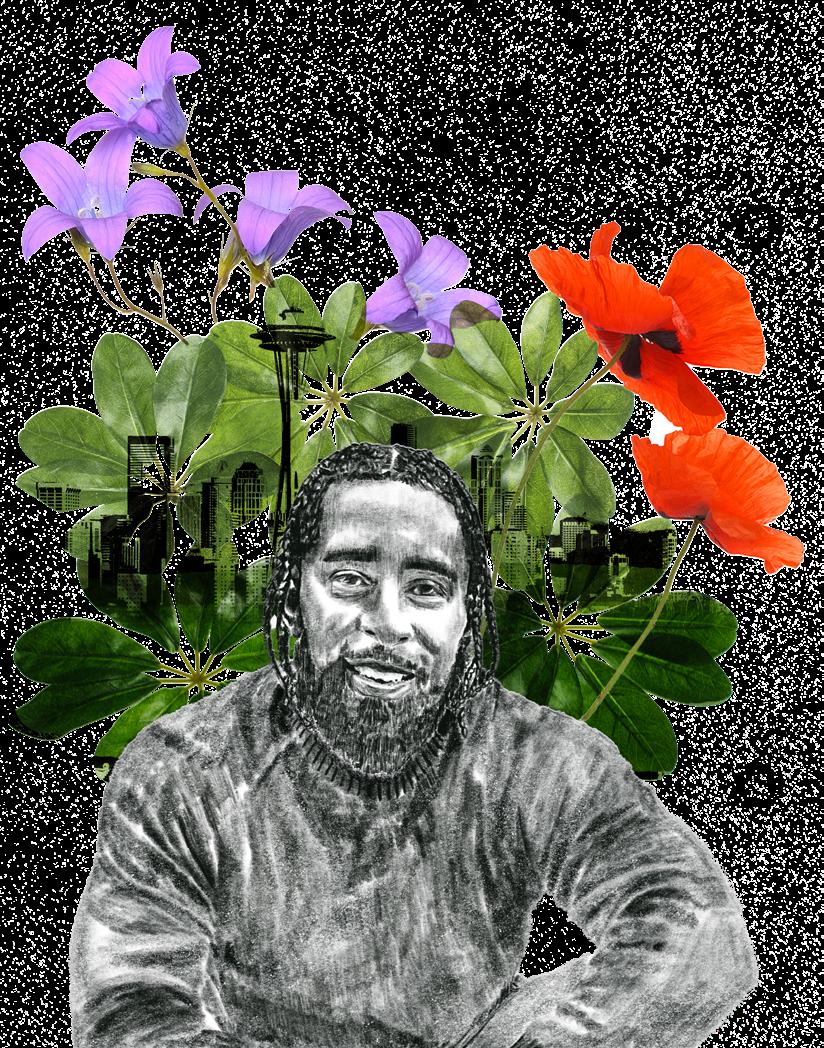
At age 31 the father, son and brother—and a stalwart member of the community—was shot and killed Oct. 19, 2022, while locking up The Postman. His tragic death shocked and devastated not only Pickett’s close-knit family and friends, but his entire community and the SU community as well.
For three years starting in 2020 The Postman partnered with the Project Center, which teams up businesses, government agencies and nonprofits with SU seniors majoring in STEM fields to focus on a project, giving students valuable on-the-job and real-world experience.
The D’Vonne Pickett Jr. Endowment will ensure that small businesses, particularly Black- and minority-owned, will be able to participate and benefit from these partnerships.
To fund the endowment, Seattle University set the goal of $100,000 and the Ellison Foundation has pledged to match donations up to $50,000. Rachael Brown, director of the Project Center, says that through the D’vonne Pickett Jr. Endowment, the center will carry forth the Picketts’ legacy of forging profound connections and uplifting the community.
“By engaging with local Black- and minority-owned businesses, we are able to show our students the positive impact that diverse entrepreneurs have in business,” Brown says. “This commitment embodies D’vonne and KeAnna’s spirit of empowering youth to envision and achieve their greatest dreams.”
The work enabled by the endowment is something KeAnna Rose Pickett says aligned with her late husband’s life goals.
“D’Vonne had this tidal wave effect on people, just how he lived his life and how that affected others,” she says. “That’s what makes me feel good about this effort, that it gives people opportunities to live out those values that D’Vonne lived.”


In the short time he had, Pickett touched multitudes in his hometown not only as a basketball player for Rainier Beach High School and the Redhawks, but also as a forward-looking force for positivity.
“He understood once he got to Seattle University, as I did, that it’s bigger than basketball,” says Pickett’s friend Fred Wilson, ‘17, who also played basketball for the Redhawks. “Getting a degree, being one of the first people in your family to get a degree, opening a business, not only to help you be successful but also to bring up others and give them opportunities.”
Pickett’s roots in Seattle run deep, from his family to the broader community. Though he was focused on the future, he took care to respect the past. The Postman honors his great-grandfather, Jacques Chappell, a U.S. Postal Service letter carrier who delivered mail on routes in Queen Anne and downtown.
“He was everything to me, everything to his family, his kids and community,” Pickett’s mother, Nicky Chappell, says of her son. “He was definitely a pillar in our community.”
Pickett’s sister, De’Auz’janae Pickett, says her brother focused his life on substance. That meant doing things that mattered for people, a principle he called “heavy over airy,” something even strangers he chatted up in the supermarket could sense.
“That was his life’s philosophy,” De’Auz’janae says, calling him a provider for their family and community. “Heavy was standing on solid principles, doing honorable things.”
She says their family instilled in her brother and her these values, though tragedy had visited the family before.
D’vonne and De’Auz’janae’s father, D’Vonne Pickett Sr., was shot and paralyzed from the neck down when the children were young. He remained a large part of their lives. His death at age 31, when D’Vonne was just about to graduate from 8th grade, made his children appreciate what they had and strive for something better.
“Everything he did was gigantic,” De’Auz’janae says of her brother.
“Everything he did was going for the gusto.”
Friends Wanted to Honor Pickett’s Legacy
The seeds of the idea of establishing an enduring tribute to Pickett through an endowment were planted when two friends, who also had connections to SU, caught up after hearing of Pickett’s death.
Wilson grew up with Pickett in the Central District, playing youth sports blocks away from the campus where they both graduated college.
Following his playing days, Wilson served as an undergraduate assistant coach for men’s basketball for a year while Pickett played. He knew all along that there was more to Pickett than basketball, in particular his kind heart and desire to see those around him succeed whether on the court or in life.
“D’Vonne had this tidal wave effect on people, just how he lived his life and how that affected others.”
—keanna rose pickett on her late husband
“D’Vonne going to Seattle University, it changed his mindset, it changed my mindset,” Wilson says. “It helped him think bigger, think family, think business.”
Taylor Olson, ‘10, a former member of the men’s basketball team, first met Pickett when they were youngsters involved with Seattle Rotary Select, the AAU basketball program run out of the Central District Boys and Girls Club. They remained in touch well into their 20s, and after graduating from SU would catch up while working out at the Eisiminger Fitness Center.
“The thing that touched me right away was the number of people who showed their support in the days and weeks after D’Vonne’s death, how many people respected and looked up to him outside of sports,” Olson says.
The endowment aligned with the philanthropic strategy of the Ellison Foundation, says Ryan Webb, ’09, Community Engagement Officer for the foundation, with its emphasis on expanding educational access.
But Pickett’s death also struck a personal chord with Webb, another former men’s basketball member who played with Pickett in the Jamal Crawford Pro-AM and followed his career at SU and at The Postman.
“The news of his death really hit me: as a fellow Redhawk, as a fellow community member and as a family man,” Webb says. When a teammate told him about the movement to start an endowment in Pickett’s name Webb brought it to the Ellison Foundation’s Executive Director, Bob Hurlbut.
“D’Vonne’s passing has and never will sit right with me,” Webb says. “And at the time, I felt helpless in terms of support. I feel so fortunate that I’m allowed to be a part of this opportunity to keep D’Vonne’s legacy alive at Seattle University.”
Both Wilson and Taylor were excited by the idea of the endowment. First, because it was something that would continue for years to come, keeping Pickett’s memory alive. Second, it would provide opportunities for students who weren’t necessarily involved in sports and would assist people of color who started their own businesses.
“He would love this,” says Wilson. Almost to a person, when those who knew and loved Pickett were asked how he would respond to learning that an endowment had been established in his name, they all gave his familiar response of joy, surprise and disbelief: “Stop playing!”
The endowment is something his mother says D’Vonne would have supported himself. “He would be so proud,” says Chappell. “My baby set the bar really high.”
In addition to his wife and mother, Pickett is survived by his three children, Khloe, D’Vonne III and Xavier and three younger sisters.
Dr. Bill Weis left northwest Ohio and a job with an accounting firm in 1973, bound for Seattle. “I remember driving over Snoqualmie Pass and thinking Ohio is not gonna see me again. I made the move and never looked back.” This June, after 51 years at Seattle University’s Albers School of Business and Economics, Professor Weis will retire, capping a career of incredible impact.
At Albers Weis began in the accounting department, doing all the things a junior faculty member does—teach, publish, repeat. Then, around 1980, things got interesting. With a half a dozen papers on nonprofit financial reporting practices under his belt, “I thought to myself, this is lonely work. If I’m going to spend my time writing and publishing, it’s gotta have more impact on the world.” He became interested in the financial implications of smoking in the workplace. “I started writing articles on how much smoking was costing employers in terms of mortality, absenteeism, replacing carpets, washing windows, etc. And it just exploded.” Weis worked closely with then-U.S. Surgeon General C. Everett Koop, traveling the country and making the case for workplaces to go smoke-free. “Business owners always wanted to eliminate smoking but needed a financial reason to do it,” says Weis. The tobacco industry put up a relentless fight, but Weis’ efforts were instrumental in driving the smoking rate down from 35 to 12 percent. In 1984, while preparing for an accounting
class, Weis noticed a footnote in the text he was using. It cited Franciscan monk Luca Pacioli’s 1494 treatise on double-entry bookkeeping, a foundational document for modern-day accounting. Recognizing that the 500-year anniversary of the publication was just 10 years away, Weis and his Albers colleagues (Dave Tinius and Chauncey Burke) got to thinking. What began as a whimsical idea morphed into real plans for an international gathering to celebrate the document’s quincentennial in Pacioli’s birthplace, Sansepolcro, Italy. They also created a documentary on the friar’s life.
“Our goal was to get onto the front page of the Wall Street Journal,” says Weis. They succeeded … sort of. “(The accounting editor) wrote a column saying, ‘These guys are con artists. Here’s what they say they’re going to do.’ It was ‘allegedly this, allegedly that.’”
The Albers trio had the last laugh— the conference took place and the documentary was completed and subsequently shown in accounting classes throughout the world. Not only that but the experience also set the stage for a study tour Weis would lead for 17 years, which came to be known as the Dolomites Program.
As if he didn’t have enough going on with his day job, Weis took up acting in the late 1980s, performing with the Coeur d’Alene Summer Theatre. In 1994, he cofounded the Leavenworth Summer Theater with which he continues to be actively involved.
His restless spirit continued to take him in new directions at Albers, too. “After teaching accounting for 25 years, I was ready to move on,” he says. As advisor for the accounting student organization Beta Alpha Psi, Weis had launched a regional leadership conference that would come to incorporate outdoor experiential training. The students really took to it and he started offering an adapted version as a graduate-level course, which grew to 11 sections per year and helped boost retention and graduation rates.
For the second half of his time at SU, Weis has focused on leadership. He moved over to the management department and to directing the MBA program, which he managed for 15 years. A course he developed on emotional intelligence 20 years ago has become a staple of the Albers’ curriculum.
“Throughout his 51 years of teaching, Bill Weis has had an extraordinary impact on our students,” says Albers Dean Joseph Phillips. “Although we have many amazing faculty, Bill is the former professor that students are most likely to mention. That is the most important part of his legacy—his transformational work with students.”
Weis says that “being able to do different things” is what has kept him at SU these many years. “I’ve never thought of leaving.” And as he prepares for retirement, he’ll most miss “being a part of an organization that really has tried to live its mission. We’re doing something here that I had never seen in higher education.”
After a career spanning more than five decades at Albers, Bill Weis will retire
THE BILL WEIS LEGACY SCHOLARSHIP has been established to honor the extraordinary impact of its namesake and to provide support for undergraduate accounting and MBA students. donate to the scholarship

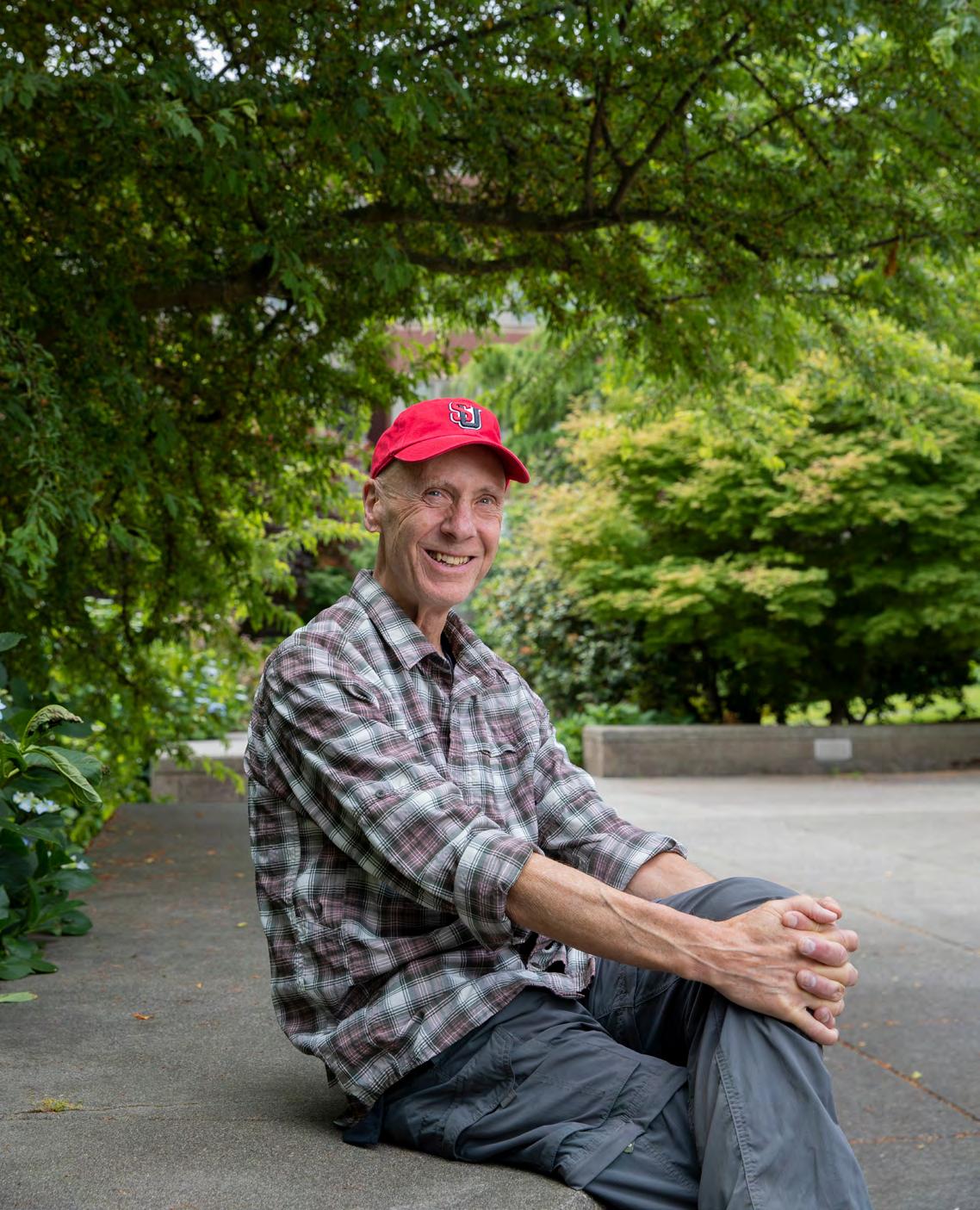
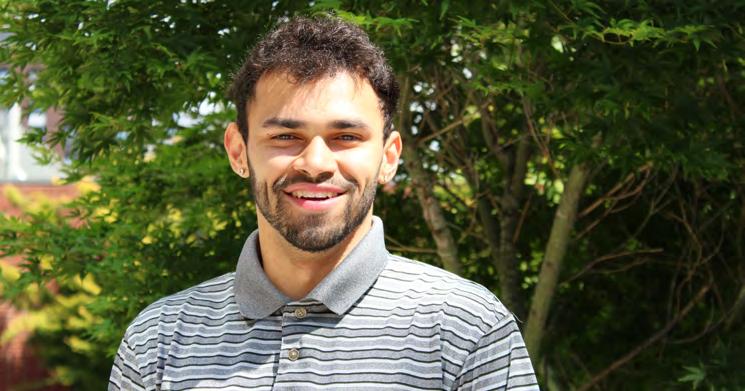
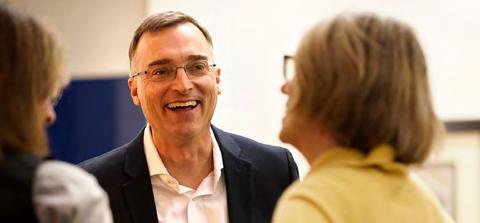


Sundborg Center for Community Engagement marks 20-year milestone with a record of building community relationships and bolstering learning opportunities for students.
by robin leshSince its inception in 2004, the Sundborg Center for Community Engagement (CCE) has facilitated transformative learning experiences for thousands of Seattle University students and fostered more than 100 partnerships between campus and community. Through the founding vision of then-President Stephen Sundborg, S.J., dedicated staff, committed campus and community partners and generous donors, CCE has sustained programs and partnerships throughout Central Seattle during a period of rapid change for both the university and the city.
“As we approach our 20th anniversary, we celebrate our collective successes and prepare for the work yet to come,” says CCE Executive Director Kent Koth. “We will
continue to focus on what we do best—focus on the community that has made CCE what it is today.”
Through CCE, Seattle University and its neighbors have worked to address significant issues such as educational inequity, gentrification and housing instability. Steeped in Jesuit and Catholic values of public service, CCE’s beginning included the creation of a student leadership program and the centralization of Community Engaged Learning (CEL) courses. During the past 20 years, the center has grown into a bustling, dynamic and thriving launchpad, connecting those both on campus and in surrounding neighborhoods through long-term, mutually beneficial partnerships.
“Our families, our children, our businesses didn’t have access to the knowledge, innovation, energy of youth, resources, creativity and new development that SU represented until the Sundborg Center for Community Engagement was created,” says Evelyn Allen, director of the Black Community Impact Alliance (BCIA).
In 2011, CCE launched the Seattle University Youth Initiative (SUYI), designed to unite the university and the wider Seattle community to support the development of successful youth, thriving communities and an engaged campus. SUYI’s place-based
focus encompasses a 100-square block area immediately adjacent to campus. Since its inception, the Youth Initiative has become the largest community engagement effort in university history, connecting with hundreds of local children and youth, mobilizing thousands of SU students to engage and leveraging millions of dollars in public and private support for neighborhood initiatives. The effort to connect SU students to the community has had a big impact for all involved. Isaiah Payne, ’23, mentored young scholars at Washington Middle School and was named an Eddie O’Brien Student-Athlete of the Year in 2023. He credits CCE and SUYI mentoring programs with providing a bridge for him to create community.
“I wanted to be … someone special that other people could look up to,” says Payne. “My journey was about making sure that I impacted other people’s lives for the better.”
Community partnerships are vital to the success and growth of CCE. Partnerships like that with Hilltop House, which has SU students connecting with the community through courses and projects each quarter.
“Community is not a thing but rather a feeling or sense of belonging to something greater than ourselves,” says Karen Carlos, community engagement director at Hilltop House. “When we first started partnering
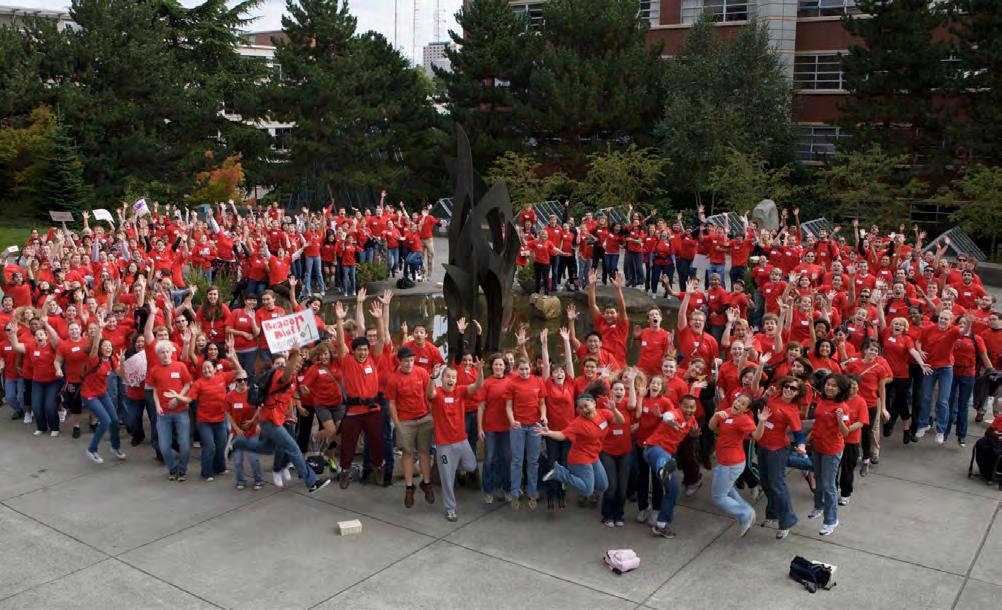
with Seattle University, I felt that Hilltop [House] was standing alone on First Hill. I was grateful to learn about the program at SU. At first it was about inviting students in to help our residents. I then became aware of the give-back I was starting to witness. It was a win-win situation. Students were helping residents with tasks and activities and residents were helping students learn about connections, interactions and the importance of service.”
Community Engaged Learning provides opportunities for students to work with and learn from the community, says Provost Fellow Rebecca McNamara, PhD, an assistant clinical professor at the Matteo Ricci Institute.
“It is a high-impact teaching practice that has been shown to increase students’ academic content learning, interpersonal skills such as communication and teamwork and their awareness of social issues and their root causes,” McNamara says. “Community Engaged Learning enlivens the Jesuit mission of Seattle University. Through experience and reflection, students are moved to act on causes and issues that are important to them and to our society.”
More than just the university and local community are taking notice of the work and initiatives of the center. In 2012, the Obama administration awarded SU
with the President’s Higher Education Community Service Award, the top award given by the federal government to an institution of higher education committed to volunteerism, service and civic engagement. The recognition highlighted a range of efforts that speak to service including health care support from the College of Nursing and legal aid from the School of Law.
CCE is a national leader among other higher education institutions, regularly recognized for its exemplary focus on community partnerships through placebased community engagement. In 2017, CCE led the effort to create the nationwide Place-Based Justice Network (PBJN), which continues today through the University of San Diego. PBJN is a learning community committed to transforming higher education and communities by deconstructing systems of oppression through place-based community engagement.
“For two decades, the Sundborg Center has been at the forefront of bridging town and gown,” says Chris Nayve, associate vice president for community engagement and Anchor Initiatives at the University of San Diego. “The team at CCE has been important thought leaders shaping the field of place-based community engagement. What we appreciate so much is the generosity of spirit and collegiality. They

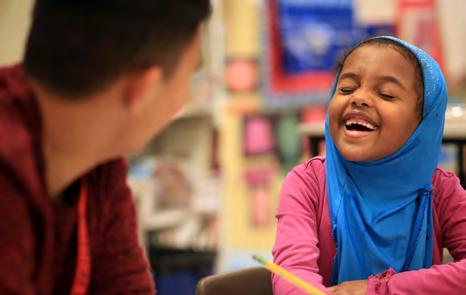
are considered leaders in convening and sharing wisdom with colleagues from across the country on how to intentionally cocreate and integrate community voice and wisdom.”
Looking to the future, CCE’s 2030 Strategic Directions plan is well underway. Strategies focus on strengthening and enhancing the Youth Initiative, fostering leadership through transformational learning experiences and reimagining systems by pursuing equity through innovation and iteration. This includes a major expansion of Community Engaged Learning courses and a new commitment for SUYI youth to attend Seattle University.
“I admire how the center, with its mission, organically develops to respond over these 20 years to what is most needed and possible at different times and in changing contexts,” says Father Sundborg. “It is always growing and changing.”
The Sundborg Center for Community Engagement will celebrate its 20th anniversary on March 14, 4:30-7 p.m. at Seattle University’s Campion Ballroom.
Led by faculty and with support from an NSF ADVANCE award, SU is changing the way it grants full professorships, with positive impacts for women and faculty of color.
by tina potterf and andrew binionIt is work that longtime Seattle University Chemistry Professor Jenny Loertscher, PhD, calls “bold and daring,” a reimagining of the way the university grants full professorships. This is institutional transformation—many years in the making—that arguably fixes a system that didn’t always take into account the totality of a faculty-scholars’ work and achievements.
With the backing of a National Science Foundation (NSF) ADVANCE Institutional Transformation Award and led by a coalition of faculty, Seattle University is a leader of this work that transformed the professoriate and culture by better supporting the recruitment, retention, evaluation and advancement of a more diverse faculty—particularly women faculty and faculty of color—reflective of the diversity of the student body. The end result is a new set of guidelines that are used for tenured faculty seeking full professorship.
Prior to the revision, the guidelines used for tenure—for example, an assistant professor becoming an associate professor—were the same for full professor. “What we saw happen was that faculty would get tenure,” explains Loertscher, “and then some would stall out as associate professor, never reaching full professorship.”
“The standards that are largely used by higher ed institutions were developed years ago, when there wasn’t the diversity we have now. It makes sense in the 21st century that we would need to reevaluate these guidelines,” Loertscher continues. “We were only able to do what we did because people are really invested in our mission in a real way here. We believe in and live out our mission.”
The process to arrive at these new guidelines involved consensus-building over many years
and across campus with faculty and various university stakeholders. But the effect of these changes is already being seen.
Since 2021, of the 35 faculty promoted to full professor, 23 are women and 16 are faculty of color—this represents a sizable shift, in just a few short years, in increasing the number of tenured faculty earning full professorships.
The important work of recruiting, retaining and advancing more women and faculty of color at Seattle University began in 2016 when SU received the ADVANCE grant— providing funding for six years—and it has expanded with a recent NSF Partnership award in conjunction with two other Jesuit universities, Gonzaga and St. Louis University, who are using SU’s work as a model for their own process of faculty professorships.
“There is substantial evidence demonstrating that women and faculty of color engage in activities that directly benefit students, universities and communities, but these contributions are not easily captured in traditional measures of faculty success,” explains Professor Jodi O’Brien, PhD, who is vice provost for faculty affairs and a leader in drafting the initial proposal and developing the grant-funded program.
“Through our NSF ADVANCE award, SU has successfully reimagined faculty performance, introducing alternative models of evaluation and standards of promotion that recognize and reward a comprehensive and inclusive range of faculty activities.”
The promotion and recruitment of faculty members who best represent the changing makeup of SU’s diverse student body is an important outcome of these revised guidelines, says Professor of English MaryAntoinette Smith, PhD.
“If we don’t have more faculty of color, as our students become more diverse, we need faculty that look like them so as to not revictimize them,” says Smith, who teaches English—her focus is 18th and 19th Century British Literature—and in Women, Gender & Sexuality Studies.
Now more on these guidelines: In addition to evaluating faculty by traditional methods— excellent teaching, established research and scholarship, publications and peer review— SU is now recognizing faculty contributions to student success, public engagement, community-engaged scholarship, applied scholarship, student-faculty research and institution building.
Associate Professor of Mechanical Engineering Yen-Lin Han, PhD, who started at Seattle University in 2012, says traditional guidelines for promotion can often give short shrift to these kinds of achievements, which directly affect student success.
“My work, which includes lots of handson innovations through projects, working with industry, placing my students in those companies, is actually impactful for my students,” Han says. Since receiving tenure, she has earned one granted patent and nine pending patents for autonomous vehicles and robotics, accolades she says would have been challenging to be counted when considering her for promotion under the traditional guidelines.
Further, she says the new guidelines for the review process allow for external subject experts outside of academia, some of whom are in cutting-edge fields and industries.
“The new guidelines really recognize and put that work as something that could be
continued on page 36


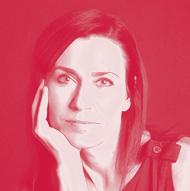
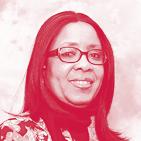


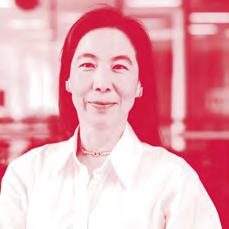
 jenny loertscher, phd Chemistry Professor
angelique m. davis, jd Political Science Professor
geneva “eva” sedgwick, jd, llm Business Law/Marketing Professor, Director, MBA in Sport and Entertainment Management
mary antoinette-smith, phd English and Women, Gender & Sexuality Studies Professor
yen-lin han, phd Mechanical Engineering Associate Professor
paulette kidder, phd Philosophy Professor
colette taylor, edd Professor/Special Assistant to the Provost
jodi o’brien, phd Sociology Professor/Vice Provost, Faculty Affairs
jenny loertscher, phd Chemistry Professor
angelique m. davis, jd Political Science Professor
geneva “eva” sedgwick, jd, llm Business Law/Marketing Professor, Director, MBA in Sport and Entertainment Management
mary antoinette-smith, phd English and Women, Gender & Sexuality Studies Professor
yen-lin han, phd Mechanical Engineering Associate Professor
paulette kidder, phd Philosophy Professor
colette taylor, edd Professor/Special Assistant to the Provost
jodi o’brien, phd Sociology Professor/Vice Provost, Faculty Affairs
As executive director of the Institute for Catholic Thought and Culture, Professor Jeanette Rodriguez, PhD, is answering Pope Francis’ call to action on the climate crisis.
by andrew binion


Bible in one hand, newspaper in the other, that is the perspective Jeanette Rodriguez, PhD, has on liberation theology, the Latin American Catholic tradition of reflecting on the gospel from the perspective of the poor and most vulnerable while engaging the world with Christian values and thought to address injustice and the climate crisis.
“Historically, in the Catholic intellectual tradition, people tend to go to Augustine or Aquinas, our intellectual giants, but we also need to engage the social sciences in order to respond to the complex social issues of the day,” Rodriguez says. “It’s not enough to absorb and transmit this repository of knowledge, but also to create and contribute to it.”
As executive director of the Seattle University Institute for Catholic Thought and Culture (ICTC), Rodriguez counts herself as a witness scholar in the tradition of Latin American liberation theology— hence listening to and learning from the world by reading the “signs of the times.”
Rodriguez is a tenured professor of Theology and Religious Studies who has also taught in the former School of Theology and Ministry as well as the graduate program for Couples and Family Therapy. Additionally, her classes have been cross-listed with Women, Gender & Sexuality Studies and Latin American Studies.
Through her career Rodriguez has engaged in a variety of scholarship, including Hispanic spirituality and women, and as a renowned Guadalupian scholar whose 1994 book Our Lady of Guadalupe: Faith and Empowerment among MexicanAmerican Women remains in print. Her latest book, Women Called to Catholic Priesthood: From Ecclesial Challenge to Spiritual Renewal, written with SU Professor Emerita Sharon Henderson Callahan, is due to be released in March.
In recent years her time has been devoted to the ICTC, founded in 2012, which she has been leading since 2019, first as interim director and then promoted to executive director in 2022.
As its leader she is responsible for bringing a Catholic lens to view the modern world, creating a newsletter and programs to highlight the intellectual traditions that have had an abiding influence on shaping societies, such as the Catholic Heritage Lecture Series.
One of Rodriguez’s more pressing tasks is integrating the repeated calls from Pope Francis for the world to care for our common home and confront the danger posed by climate change, first articulated in the 2015 encyclical Laudato Si’ and then fortified last year with Laudate Deum, an apostolic exhortation on the climate crisis.
In addition to liberation theology, Rodriguez also lives by another principle. This one guided her around the globe—to Guam, Micronesia, Japan, Taiwan, the Philippines, Central and South America and South Africa—before finding a home at Seattle University in 1990. It springs from her family and background as the daughter of two Ecuadorian immigrants who raised seven children in the Astoria projects in Queens, New York.
That principle is to cast aside fear and face the world with hope and faith.
“My father would always push us like that,” says Rodriguez, whose talent for languages and willingness to ask helped her land her first job out of college as a tour guide at the United Nations in New York. “‘No’ is not going to kill you. Go try, ask. And so I kind of operate that way. If there’s something I want, I ask. And if they say no, OK. But surprisingly, a lot of people say ‘yes.’”
“Thanks, dad,” she adds.
With Laudato Si’, Pope Francis sought to steer the Catholic community toward caring for creation as a duty to the young and vulnerable. The encyclical set off a chain of events that have led to a global revaluation of power and a commitment from Seattle University. In the exhortation that followed, the Pope argued that
progress is not happening fast enough in light of the dire circumstances and deplored climate denialism.
“In both Laudato Si’ and Laudate Deum, the pope is addressing both Catholics and people of goodwill,” Rodriguez says. “It’s important to note that he doesn’t say ‘climate change,’ he says ‘climate crisis.’ I think that shift in language, that sometimes people might miss, is significant.”
SU President Eduardo Peñalver signed in 2021 a letter of commitment for the university to participate in the Laudato Si’ Action Platform and the “Seven-Year Journey Toward Integral Ecology.”
When the university sought to put the commitment into action, Rodriguez reached out to Yolanda Cieters, associate director of sustainability, at the Center for Environmental Justice and Sustainability.
“Dr. Rodriguez was very intentional about bringing together some key actors from around campus, asking questions about what this means to the university and how to translate the call from the pope into taking action,” says Cieters. She hailed Rodriguez’s leadership for weaving together the strands that make up the action platform’s mission and doing so in a way that aligns with the university’s values. “When she takes initiative, when she leads, acts and collaborates, there is really very deep thought behind it,” says Cieters, crediting Rodriguez with asking vital questions to ensure that not only does the process run smoothly but also that it is done right and successfully.
In her spare time, Rodriguez likes to dance and spend time with her son Joshua, daughter, Gabriella, son-in-law James and her two grandchildren, Issac and Ezra.
She makes time for Sunday group Zoom calls with all her siblings and checks on her father, Gonzalo Victor, who at 99 years old still reads the newspaper every day, along with praying two hours a day and playing chess.
This year’s honorees reflect the best in service, community engagement and athletic excellence.
stories by andrew binion, tina potterf and mike thee

They stand at the forefront of innovation, change and progress. They embody leadership, are catalysts for transformation and make their communities better. They are this year’s Alumni Award recipients and the newest inductees into the Athletics Hall of Fame.
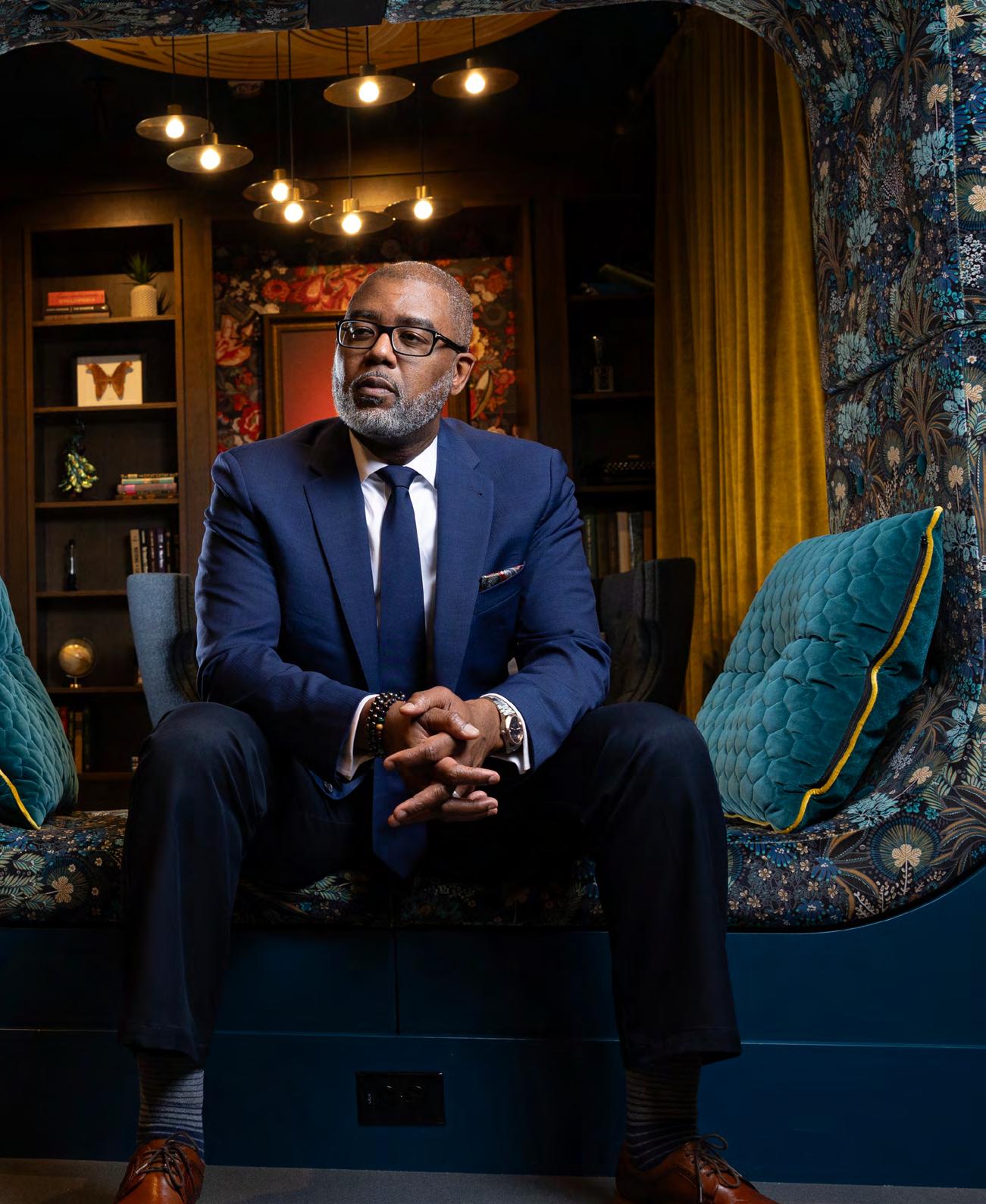 Craig Sims, ’97 JD
Craig Sims, ’97 JD
A pioneer who has touched the lives of many, Dorothy Cordova has had an indelible impact through selfless service.
by mike thee
At 91 years of age, Dorothy Cordova, ’53, goes into the office every day— just as she’s been doing since 1982, when she and her late husband Fred Cordova, ’52, cofounded the Filipino American National Historical Society (FAHNS). Not even COVID could keep her away from FANHS, which is located just a short walk up the hill from Seattle University in the basement of a school attached to Immaculate Conception Church.
“People ask me why I come here every day,” Cordova says, seated at her desk amid a trove of photos, documents and other historical objects. “It’s because I don’t know everything.”
Cordova grew up in Seattle’s Central District—or the Central Area, as it was then called—the daughter of Filipino immigrants. “My mom was a storyteller. Many nights after we did the dinner dishes, mom would sit there and talk about the Philippines.”
Cordova went to an elementary school primarily attended by Japanese American students and remembers riding the bus during World War II as discrimination against Japanese Americans spiked. “People at the bus stop would shake their fists at us and call us the enemy,” she says. “We were kids . . . I realized something was askew. I got my sense of social justice early.”
When Cordova was around 11, her mother hosted a Filipino Jesuit priest who was teaching at Seattle College and over dinner, “He asked me if I got good grades. I told him I had straight As and he said, ‘You will go to Seattle College.’”
By the time Cordova arrived on campus as a first-year student, Seattle College had become Seattle University. Early on, she helped start a student club which, as part of a Homecoming competition, created a Filipino village. “None of us had been to the Philippines, but we made vines of flowers, played Filipino music and wore Filipino dresses. It was all make-believe,” she says, with a laugh, “but we won first place and that was the beginning of my SU experience. We felt like we were going to make our mark.”
Pivoting from her original plan to be a medical technician, Cordova changed her major to sociology during her sophomore year. She particularly appreciated “the Jesuit twist on sociology” and how one particular professor taught that the discipline “has to be based on altruism and empathy.”
“For me, SU was a good place. It’s where I got a lot of my grounding.”
It’s also where she met her husband and over the next six decades their partnership would enrich the lives
of countless people in the Seattle area and beyond. Together, the Cordovas cofounded an organization for Filipino youths and while Fred worked in journalism and public relations, Dorothy undertook a number of state and federal research projects focused on Asian Americans and immigrants—all while raising eight children. Her extensive social research and community organizing activities led to the creation of FAHNS and, from humble beginnings in an office at SU, the organization has grown to include 42 chapters nationwide.
In addition to being named this year’s Alumna of the Year, Cordova served on the university’s Board of Regents from 1980 to 1991, and she and Fred (known by many as “Auntie Dorothy” and “Uncle Fred”) jointly received an honorary doctorate from the university in 1998.
Says Angel Asuncion-Reed, ’23, who nominated Cordova, “Dorothy epitomizes all the values of care, not just for the whole person and service to others, but she and Fred have sustained, lifted and advocated for an entire Filipino American community and its history. FANHS has been integral in academic and civic engagement, the arts and more.”
Of her alumni award, Cordova says, “I’m overwhelmed and really humbled by all of this.”
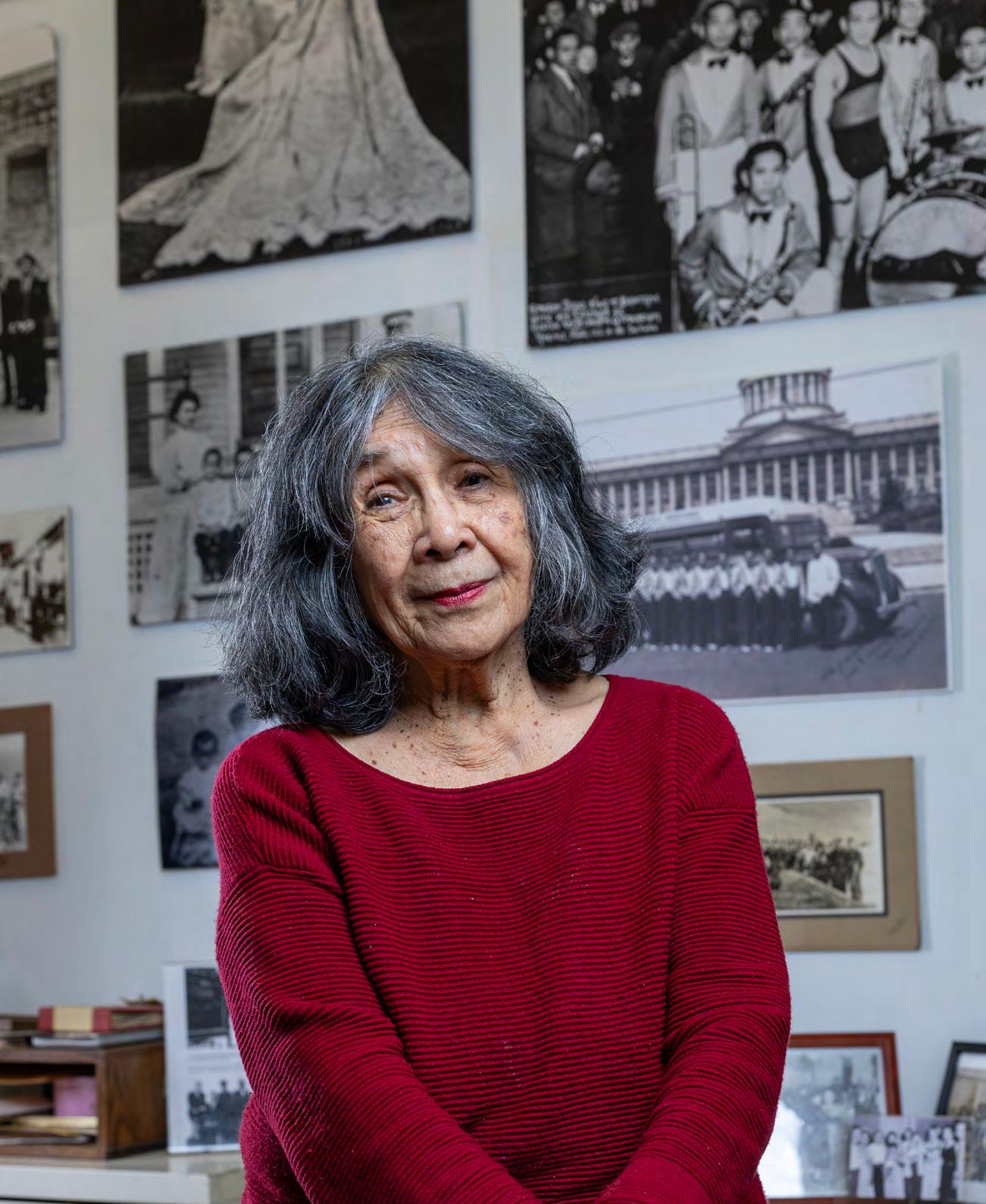
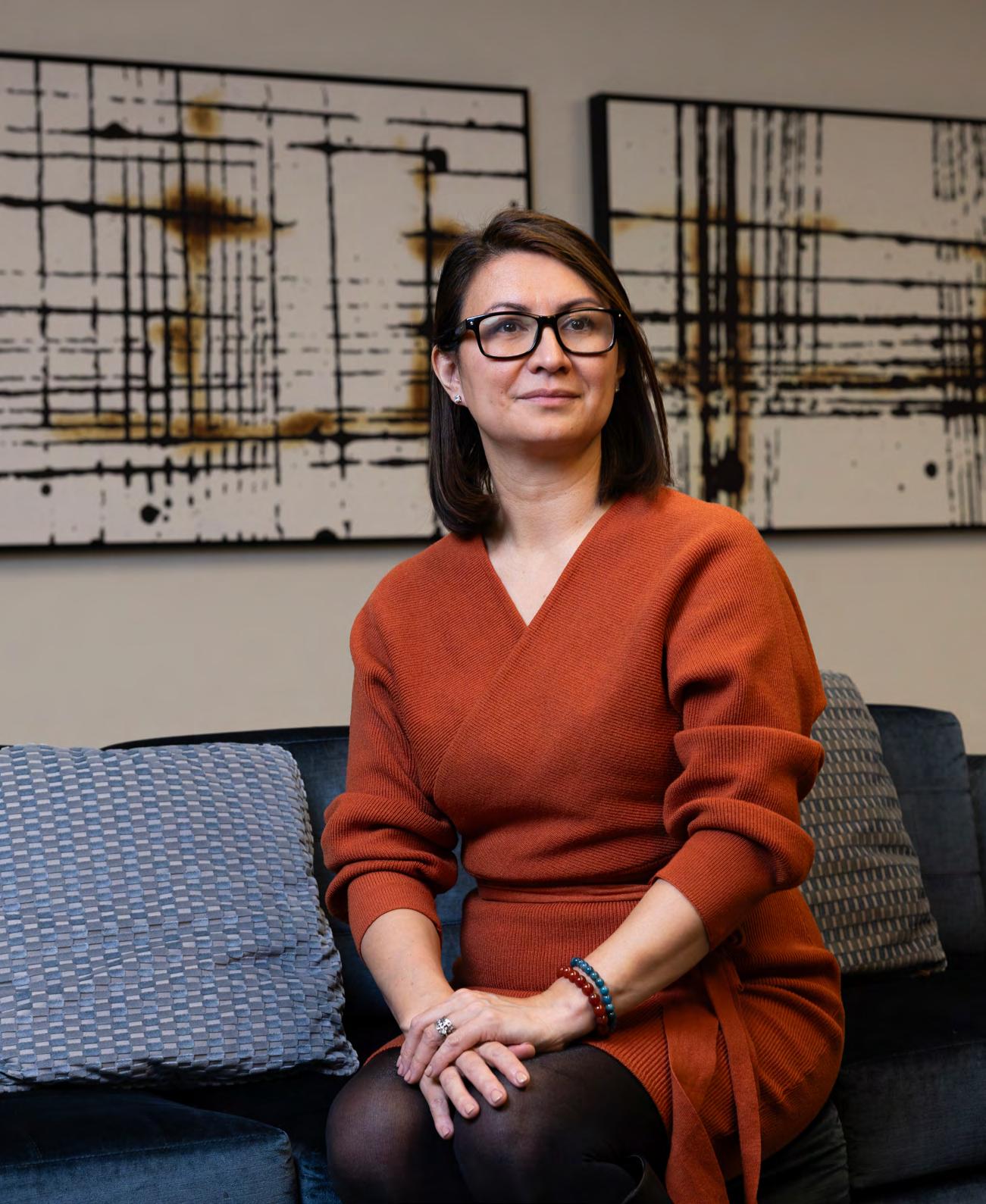
Renee Rassilyer-Bomers was instrumental in setting up immunization clinics during the pandemic that became a national model.
by mike theeLooking back now, a career in health care seemed all but destined for Dr. Renee Rassilyer-Bomers. With both her mother and father working in the field, she says, “I grew up in the hospital, dropping off lunches and spending time there. From a young age, I had a drive to be a nurse.”
That drive only grew stronger when, as a middle school student, she participated in SPLASH, a nationally recognized summer camp at Seattle University. Run by Mathematics Professor Sister Kathleen Sullivan, the program immersed girls in the sciences and mathematics and as part of the program, RassilyerBomers was placed in an internship in the ultrasound program at Swedish Hospital. “As a seventh grader, seeing scans of hearts, I really fell even more in love with health care.”
She would go on to earn multiple degrees from Seattle University—a bachelor’s in nursing and humanities, a master’s in nursing and a Doctor of Nursing Practice. And she’s not done yet as she’s on track to earn an MBA from SU in Executive Leadership. Rassilyer-Bomers has worked for more than two decades at Swedish (known today as
Providence Swedish), beginning as a phlebotomist and later a nurse technician, clinical nurse specialist and chief quality officer before being named Chief Nursing Officer of the provider’s Puget Sound central service area in 2022. In this role, she works to ensure nurses—and by extension, patients—are well taken care of, with a purview that includes decision-making, strategy, practice and financials.
Perhaps her biggest professional test thus far came in early 2021 as thousands of doses of the first COVID-19 vaccines made their way to Swedish Providence. It fell to Rassilyer-Bomers to develop a plan to get shots into the arms as efficiently and equitably as possible. Rassilyer-Bomers reached out to her alma mater to ask if SU might host a clinic. Just eight days later, Campion Ballroom was up and running and over the next four weeks nearly 50,000 immunizations were administered. She spearheaded a clinic at Lumen Field that served an additional 100,000 people. So successful was the effort that it attracted attention as a national model.
Dr. Kristen Swanson, who retired in 2023 as dean of Seattle University’s College of Nursing, worked closely with Rassilyer-Bomers on the campus clinic. Of Rassilyer-Bomers Swanson says, “It was equivalent to witnessing an ‘elite athlete’ in action. She displayed incredible organizational and systems leadership . . . [to ensure] vaccines were equitably distributed to all people through large venues, mobile vans and small neighborhood centers.”
Rassilyer-Bomers values the education she received—and continues to receive—at SU. “I love Jesuit education,” she says. “Looking at education from a diverse perspective, a welcoming attitude and appreciation of the whole person, that resonates with me.”
And she’s as much a purveyor as a product of Jesuit education. Serving on the nursing faculty, she’s taught nearly every class and these days is focused on helping to coordinate clinical placements. Being at the nexus of the nursing profession and nursing education allows her to foster mutually enriching connections—a “continuous loop,” as she calls it.

Craig Sims believes that we cannot succeed unless our neighbor succeeds, a philosophy that has guided him as an attorney and prosecutor.by andrew binion
Craig Sims, ‘97, graduated with his bachelor’s degree on a Sunday and the next morning arrived in Washington state and started classes at Seattle University School of Law, embarking on a lifelong journey of becoming an attorney, rising from a desire to serve others.
Drawn to the law school by its Academic Resource Center, which assists traditionally underrepresented students from the moment they walk through the door through the bar exam, Sims found a supportive community of both faculty and fellow students. His success there propelled him to first work as a prosecutor, leading other prosecutors and handling cases ranging from misdemeanors to murder, to representing clients in civil suits who have suffered injustice, whether from civil rights violations or injuries from exposure to toxic substances.
“Based on my experience in high school and college, I was always one of very few,” says Sims. “And so I knew that I wanted to be a part of a program where it almost created a
family atmosphere so that none of us were truly alone and there were people who could understand our experience and our walk in life.”
For 16 years Sims served as a prosecutor in King County and Seattle municipal courts, a role where he had a direct and lasting impact on both those who suffered from crime as well as those who sat on the other side of the courtroom from him.
In his work he was “not only helping families who have been aggrieved with a tragic loss or circumstances of a crime, but also those people who have committed crimes who sometimes just need compassion and grace,” he says.
In his civil work, Sims is known for multimillion dollar settlements and jury verdicts. In 2016, he led a trial team that won an $8.75 million asbestos jury award. He now is an attorney with Schroeter Goldmark & Bender in Seattle.
Service has been central to Sims’ success and to his mission as an attorney‚ with service stemming
from the values instilled in him growing up in the Baptist Church. Later he became familiar with the Bantu concept of Ubuntu, which rounded out his philosophy on service. The word can be translated as “I am because we are,” or in Sims’ words, “I cannot be the best I can be until my neighbor is the best that they can be.”
“That affirms for me that spirit of service that we must uplift those around us and that when we do so, we’re also uplifted ourselves,” Sims says. “To me, that’s what service is all about.”
Sims says he is grateful to be the recipient of the University Service award.
“Not that I do it for the recognition, but the recognition, the awards, to me it is confirmation that I’m acting in a way consistent with my calling.”
When not working or mentoring young attorneys he likes to spend time with his family, wife Kara and his children, Anthony, Braeden and Brooklyn.
Tresha Lacaux is a true inspiration and trailblazer in the world of aerospace.by tina potterf
For as long as she can remember Tresha Lacaux has had a passion for all things aerospace. The interest was further fueled when a school friend’s parents taught her to fly their kit aircraft and she was intrigued, knowing that one day she would design an aircraft. Fast forward to today where Lacaux is vice president and chief project engineer for the 777X airplane at The Boeing Company, where she has worked her way through the company starting as an intern in 2006 before joining as a full-time employee a year later. Originally, she worked on the technical side of the global aerospace giant before transitioning into management.
“Boeing has been an amazing place to work. My technical skills grew over time and then I had an opportunity to move into management,” she says. “I love working with technical details but I realized I loved developing people as well.”
With her resilience and purposeful leadership, Lacaux became the first Black woman to hold her current position at Boeing and played a pivotal role in developing the 777X jetliner. She has led developments in advancing aerospace technology that focuses on environmental sustainability and a commitment to high ethical standards and risk management in the STEM field.
A true trailblazer, Lacaux works in what she calls her “dream job” with
a team of 2,000 engineers and is responsible for the safety and product integrity of the aircraft.
“When I joined Boeing, I wanted to go the technical route at first. And I had a dream to become the chief engineer. I am thrilled and humbled to be in this position,” she says.
Lacaux is known for her mentorship, coaching, support and advocacy of colleagues. “A lot of my leadership style is about letting people discover their own solutions. I am a leader who provides guidance, support and positive reinforcement. Also, I create a safe space where people are allowed to fail so they can then grow,” says Lacaux.
Lacaux also recognizes the significance of representation and is an inspiration and advocate for diversifying STEM and aerospace industries.
“It’s a humbling experience to receive notes from individuals that they are inspired to see someone who looks like them in my role,” she says. “It inspires me to be the best I can.”
A transfer student to Seattle University from Virginia Tech, Lacaux earned her degree in mechanical engineering in 2007. At SU she loved the smaller classes, personalized, hands-on learning and more access to the labs and professors. “It was a deeper educational experience.”
As the recipient of the Alumni Award for Professional Achievement, it’s
an honor that “means the world to me,” Lacaux says. “Seattle University was a such an amazing highlight of my journey. I’m so glad I ended up there because I received an amazing education.” The award is the latest in an impressive panoply of accolades. Previously, Lacaux was honored with the Women of Color Professional Achievement in Industry Award and the BEYA Modern-Day Technology Leader recognition, a testament to her incredible leadership. She is an active member on the Washington Mathematics, Engineering, Science Achievement (MESA) Advisory Board, helping to develop programs and opportunities for underrepresented youth to close the STEAM (Science, Technology, Engineering, Arts and Mathematics) education gap, increase degree completion and enhance workforce diversity.
A nominator of the alumni award said, “Tresha Lacaux’s outstanding leadership is characterized by her dedication to ethical principles, commitment to diversity and inclusion, mentorship of others, active participation in community initiatives and integrity in both professional and personal spheres. Tresha’s leadership is a shining example of what can be achieved through determination, integrity and a strong commitment to service and justice.”
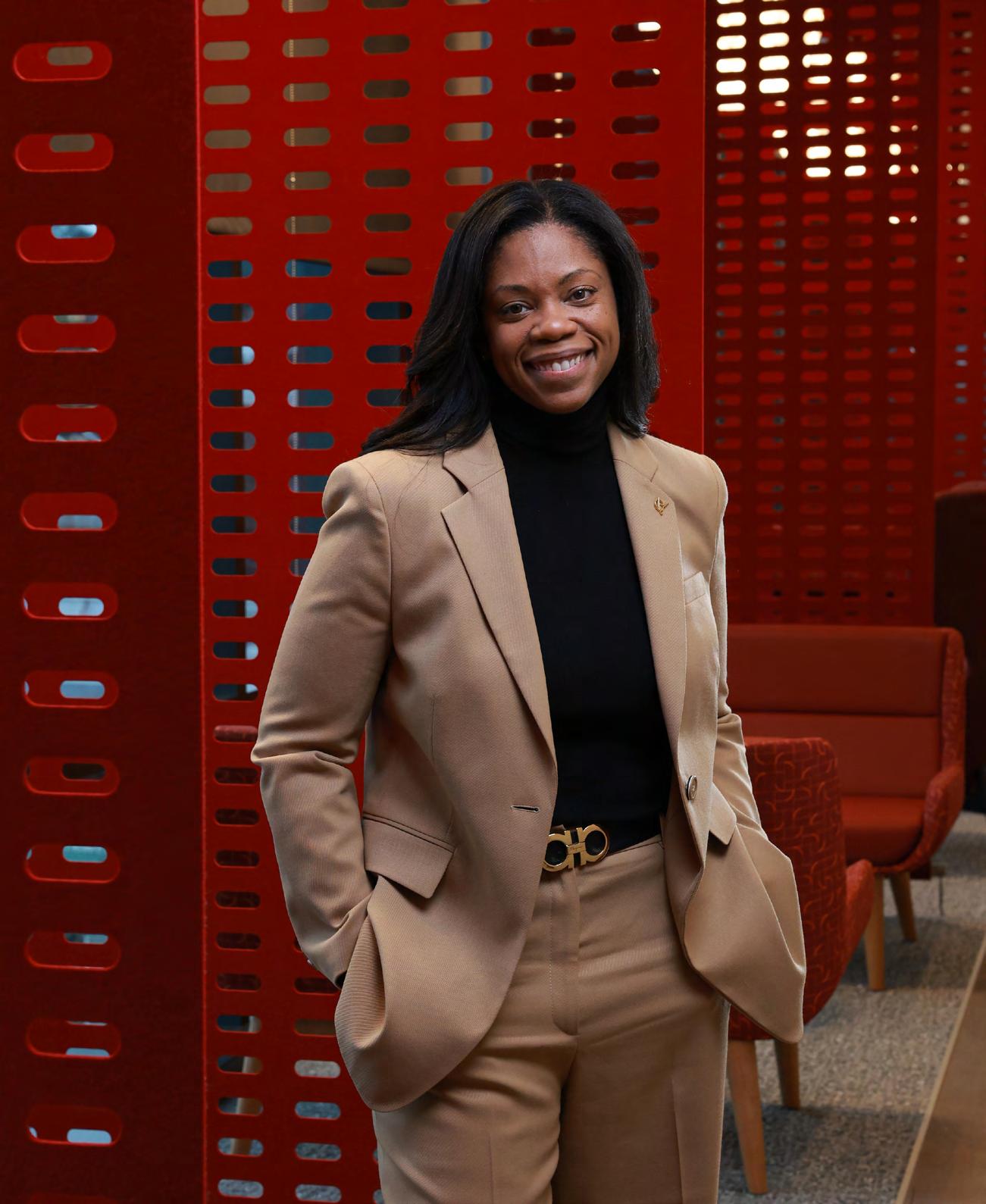
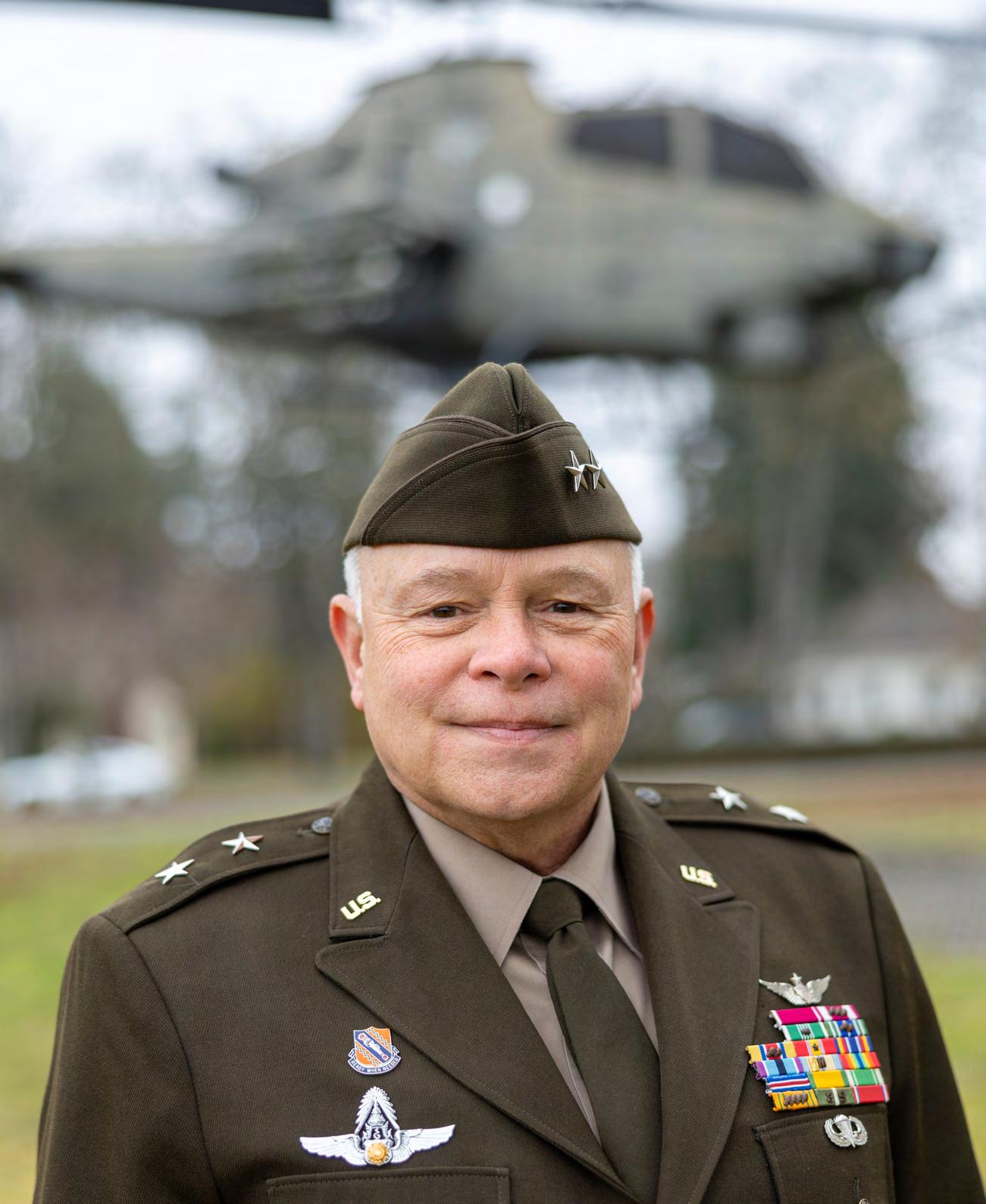
Major General Bret Daughtery says his lifetime of service— including as the top military official for Washington state—can be credited to his time at Seattle University.
by andrew binionMajor General Bret Daugherty, ‘80, ‘89 MPA, the adjutant general of Washington state, can trace his lifetime of community service from being a boy watching President John F. Kennedy on his family’s black and white TV and taking to heart his father’s advice that a rewarding life comes from service.
“I’m really proud of being a Seattle University alum,” says the Federal Way native, fifth generation Washingtonian and recipient of this year’s Community Service award. “I am very proud of Seattle University and the values that are espoused there. And truly, Seattle University is all about service and doing good and trying to make the world a better place and so am I.”
As Washington state’s commanding general of the 6,000 soldiers in the Washington Army National Guard and the 2,000 airmen in the Washington Air National Guard since 2012, Daugherty serves a role comparable to the Secretary of Defense and chairman of the Joint Chiefs of Staff. Instead of answering to the president, Daugherty answers to Gov. Jay Inlsee. He serves as a member of the governor’s executive cabinet and is also responsible for emergency management in the state and advises the governor on matters of homeland security.
And after 12 years as the adjutant general, Daughery will retire at the end of June.
“What a ride,” he wrote in his retirement announcement. “From the SR 530 landslide to the fallen I-5 bridge. From multiple floods and fires to a global pandemic. We’ve handled green crabs and murder hornets, as well as some bird flu in between.”
When Daugherty left active duty status with the Army in 1989—his last assignment was in SU’s ROTC program—he kept his commitment to community service by becoming a middle school social studies teacher in the Kent School District, a coach and a Scoutmaster. He also worked for the Washington Leadership Institute, a nonprofit housed on campus, helping high school-aged youth develop community service projects. Following the terrorist attacks of 9/11, he returned to full-time military duty in the National Guard and rose through the ranks until his appointment to the adjutant general. Not only is Daugherty a double Seattle University alum—earning degrees in psychology and a Master of Public Administration—he can rattle off his family’s extensive connections to the university.
Here he met his wife, Dolores, ‘82, and both his children are alums, who also went through ROTC and became Army officers.
He was surprised to hear he had been selected for an alumni award, but as he reflects on his 44-year military career Daugherty sees it as an amazing adventure, one that started when he arrived on campus.
“I wouldn’t have had any of the things that I have today if I hadn’t gone to SU,” he says. “My wife, my kids, my grandkids, my careers, everything came from getting lucky and getting a financial aid package to send me off for my freshman year.”
Daugherty can sum up the personal philosophy of community service that guided him, whether as a teacher working to lead kids on the right track, commanding troops, assisting families of deployed soldiers, responding to natural disasters or just dealing one-on-one with a person in need of someone to listen: the Golden Rule.
“It’s so simple,” he says. “No matter what position you are in, if we would just treat people how we want to be treated, take care of our neighbors, life is good.”

Major league baseball pitcher Tarik Skubal first learned about what sports psychologists call the ‘flow state’ from a sports and spirituality class taught by a Jesuit.
by andrew binionSeattle University was about as far from Tarik Skubal’s, ‘18, comfort zone in Arizona as he could get. When he arrived on campus as a freshman, the future big league southpaw pitcher didn’t know a soul, an experience he values as essential to his development as a person and as an athlete.
“I had to grow pretty quickly and mature and kind of take care of things,” says Skubal, who is preparing for his fourth season as a Major League Baseball pitcher with the Detroit Tigers. “There’s a lot of growth to be had when you’re uncomfortable and in a scenario you’re not necessarily used to.”
Once in Seattle, he learned he wasn’t just competing against batters—he was also competing against himself.
“The classes weren’t always easy early in the morning, that routine of being an athlete, too,” says Skubal. “It’s not always what you want to do, but it’ll all be worth it in the end.”
This year, Tarik Skubal is the newest inductee into the Athletics Hall of Fame, recognized at this year’s Alumni Awards.
Seattle University was the only Division I school to offer Skubal a scholarship and he jumped at the chance to prove himself at the college level. But he didn’t
always want to be a baseball player. Basketball was his focus growing up, but Skubal played baseball to stay in shape during the offseason. Since he could throw the ball across the plate, he got picked to pitch.
Then he started throwing harder. And harder still.
“That’s when I realized that I needed to keep doing this thing,” Skubal says. “That was my shot to go to school.”
During his time on SU’s baseball team he battled through injuries that kept him off the mound for long periods of time. His junior year he turned down an offer from the Arizona Diamondbacks, opting instead to return and play one more year for the Redhawks and complete his degree in finance.
“I just felt like there was some unfinished business,” Skubal says. His senior year he was drafted again, this time by the Detroit Tigers.
Though he missed part of last season for surgery on his throwing arm, a Detroit Free Press story in November found that when healthy, Skubal graded as the top pitcher in all major league baseball in 2023 and could end up being a Cy Young Award candidate this year.
On a personal level, 2023 also marked another important step in Skubal’s life, with his wife Jessica and
him welcoming their first child, Kasen. When he looks back on his experience at Seattle University one of the first things that comes to mind is the sports and spirituality class taught by Patrick Kelly, S.J., he took as a freshman.
“SU holds a very special place in my heart, the city, the college, the coaching staff, the teammates,” Skubal says. “It took a small-town kid from Arizona and made me grow up and taught me the value of teamwork and that brotherhood that you get playing sports.”
For Skubal, the concept Father Kelly introduced to him was the idea of a “flow state,” an intuitive focus athletes achieve when in the heat of competition.
Fr. Kelly left the university in 2019 and now teaches at the University of Detroit Mercy in his Michigan hometown. Last summer, Fr. Kelly attended a game to watch Skubal pitch. As Skubal walked out onto the field to warm up, Fr. Kelly wanted to get his attention so he shouted, “Go Redhawks!”
Skubal got a kick out of seeing his former teacher in the stands.
“I pitched well that game,” Skubal says. “So that was cool.”
is one of SU’s all-time top players in women’s hoops.by tina potterf
Kacie Sowell Timmons got her first taste of Seattle University women’s basketball when she visited here her senior year in high school. Meeting the players and coaches of a team that, at that time, was in rebuilding mode, the energy was palpable and it felt like the right fit from the jump.
Attending college in a big city and joining a team where she felt like she could make a real impact also fueled the Southern California native’s decision.
Sowell Timmons played on the women’s basketball team all four years at SU (2010-14) as she earned a degree in Sport and Exercise Science.
“I really loved playing basketball at Seattle University. We had such a good community around us and night after night those same fans were in their seats to cheer us on, even when we weren’t that good,” she says. “The team was just a fun experience all around. Just getting to play basketball in a college setting—what you work for in high school—and to live out that dream is pretty amazing.”
Today a nurse in Ventura, Calif., the city where she grew up, Sowell Timmons was a multi-sports player as a kid, splitting time between soccer, softball, volleyball and basketball— the latter three she played in high school. Interestingly, basketball wasn’t her best sport so much so that
she thought that she would likely get recruited to play softball at the college level.
“But I loved basketball the most. Starting my junior year, I went all in on basketball. The pace and energy of basketball, and everything about it, made it what I wanted to do,” she recalls.
On SU’s team, Sowell Timmons was a superstar, existing in rarefied air by the end of her final season as one of only four players in program history to score 1,000 points and 1,000 rebounds. As she sees it, these achievements were made possible with the help of those around her.
“I felt so fortunate to be part of that team. At the time we were just working together to win games,” she says. “I don’t think I could have those accomplishments without those people around me, from the coaches to my teammates. I went in a little underrecruited, underdeveloped as a player and the coaching staff saw that and for me it was every year trying to get better, every day getting better.”
Off the court she excelled as a student, evidenced by academic accolades such as her selection to the 2014 Division 1-AAA Athletic Directors Association Scholar-Athlete team.
Following graduation, she played
pro overseas for a year in Germany before returning to the states to attend nursing school at Cal State University, Northridge. She’s been a nurse since 2017 and currently works as a clinical manager for a company that provides in-home care for pediatric patients and those with chronic long-term health challenges. What does it mean to Sowell Timmons to be inducted into the Athletics Hall of Fame? In a word: gratitude.
“It is very special for me to be recognized. I am really grateful and feel like I couldn’t do anything without the teammates, coaches, athletic trainers keeping us healthy for the season,” she says. “I’m super grateful for the award.”
Award nominator Sue Stimac Verduin ‘83, a women’s basketball alumna and Hall of Fame committee member, said of Sowell Timmons: “One of the most successful runs for SU Women’s Basketball were the 2011, 2012 and 2013 teams anchored by Kacie. She led the team to back-to-back 20-win seasons, a conference title and a first ever trip to the National Invitational Tournament in 2013. Kacie’s stats and accolades on the court speak to her determination for constant improvement and growth as a player. … She epitomizes what it means to be a Seattle University student athlete!”
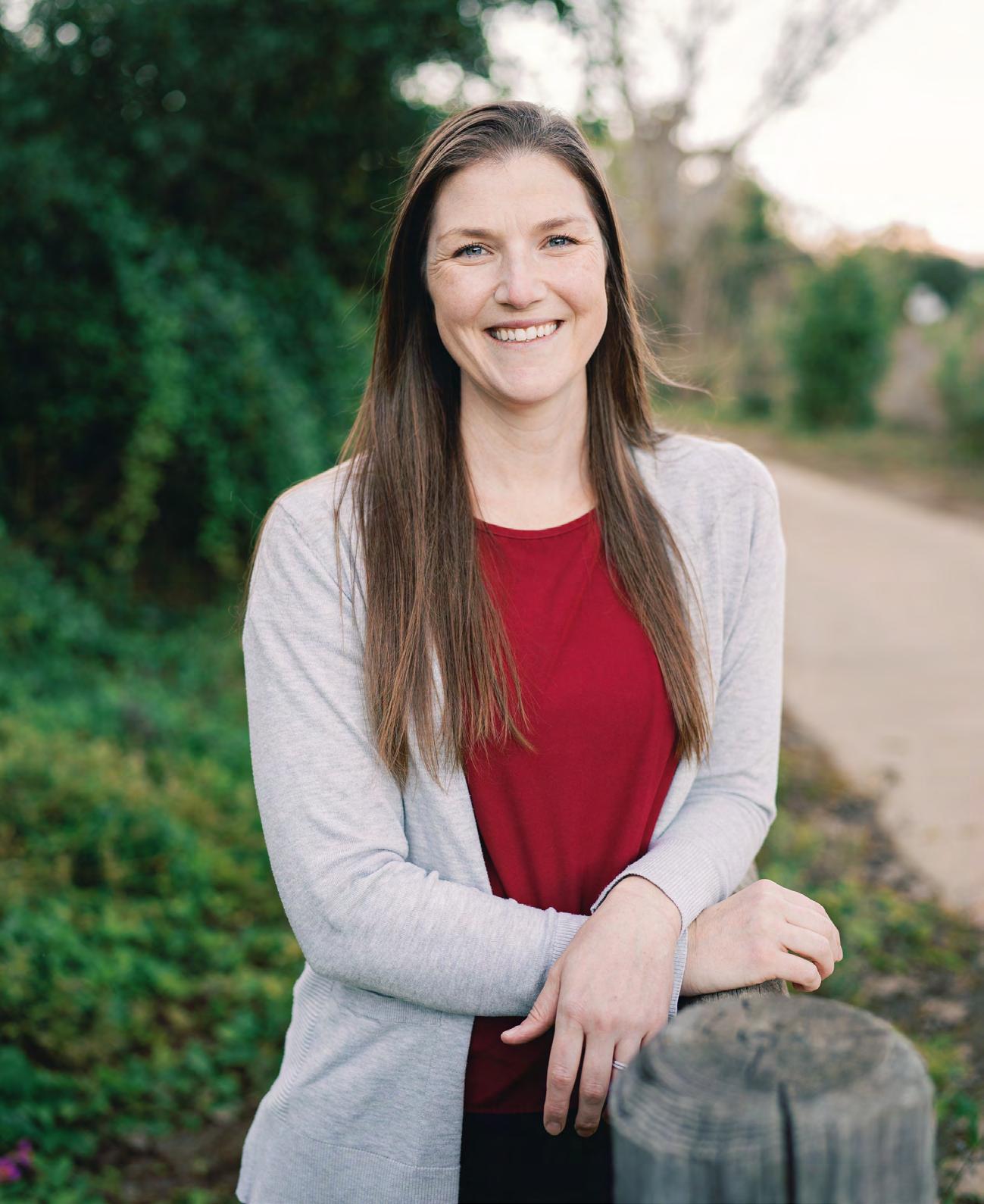


On February 29, giving really took flight as the entire Seattle University community came together to invest in the departments, programs and clubs closest to their hearts for SU Gives. And give big you all did as more than $1.2 million was raised from 3,802 gifts—the most ever for SU Gives!
Seattle U Gives dedicates 24 hours for alums, staff, faculty and friends of the university to donate to initiatives enhancing the student experience and enriching the campus community.
Although the single day of giving is behind us you can still make a gift that will greatly benefit the students and the campus community as a whole.
While gifts can still be made to a variety of areas and programs around campus, this year we highlighted one particular fund that lends support campuswide—the SU Fund.
Aptly named, the SU Fund provides crucial funding for anything and everything Seattle University. From maintaining the beautiful gardens to providing integral funding for research, this fund amplifies SU’s ability to be nimble and responsive and to make an immediate impact.

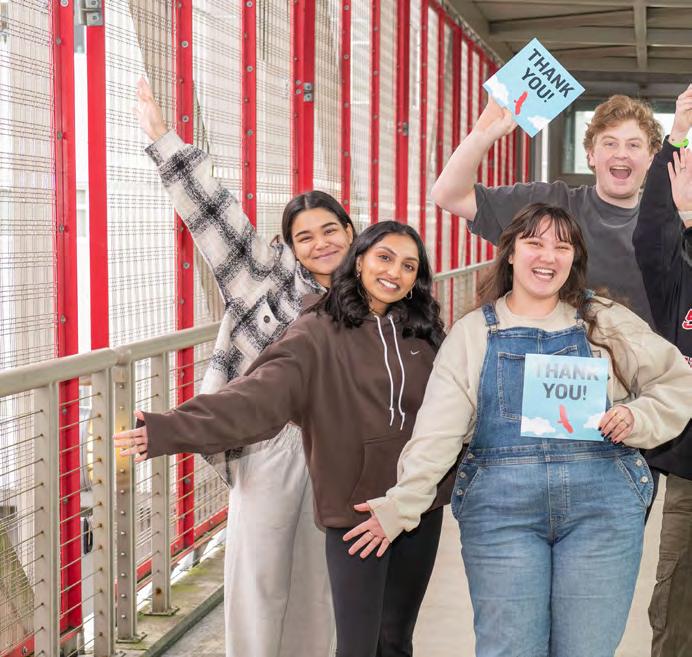
At Seattle University, 96 percent of incoming undergraduates receive financial aid. Along with the generous scholarships already established for students with affiliation to specific colleges, departments and backgrounds, nearly one-third of the SU Fund annually bolsters SU’s ability to offer additional scholarships to ensure affordability for the next generation of Redhawks. As families recover from the aftermath of the COVID-19 pandemic and economic challenges, there is tremendous financial need from incoming students. The SU Fund plays a major role in alleviating these needs and ensuring that students can focus on school.
How could we hope to equip our students for success without investing in our faculty? The SU Fund helps provide professional development opportunities for faculty so they have the tools necessary to prepare our students to be the kinds of leaders the world so urgently needs.
Additionally, the SU Fund is one of several funds supporting the integral work of reimagining and revising SU’s curriculum through the Provost Fellows—a group of faculty leaders working to review and revise the curriculum of all undergraduate and graduate departments and programs. Today, Provost Fellows are working to create a curriculum that employs Ignatian pedagogy and prepares students to respond to the great challenges facing our society, from sustainability and climate change to racial injustice and rapid technological change.
The SU Fund is used to equip classrooms and labs with the resources necessary to ensure student academic success. It also supports the maintenance of the beautiful outdoor spaces and recreation facilities that contribute to the well-being of the campus and community as a whole.
Our multifaceted students need different types of support to be successful, which is why The MOSAIC Center leverages support from the SU Fund to provide unique programs and resources. These support students of color, first-generation and undocumented students, LGBTQIA+ and veterans and militaryconnected students, commuters, transfer and graduate students and adult learners.
By supporting the SU Fund, you contribute to ensuring that Seattle University has the resources to provide the quality, transformative student experience we are known for—preparing leaders to build a more just and humane world.
To support the SU Fund and other campus initiatives, visit www.seattleu.edu/giving.
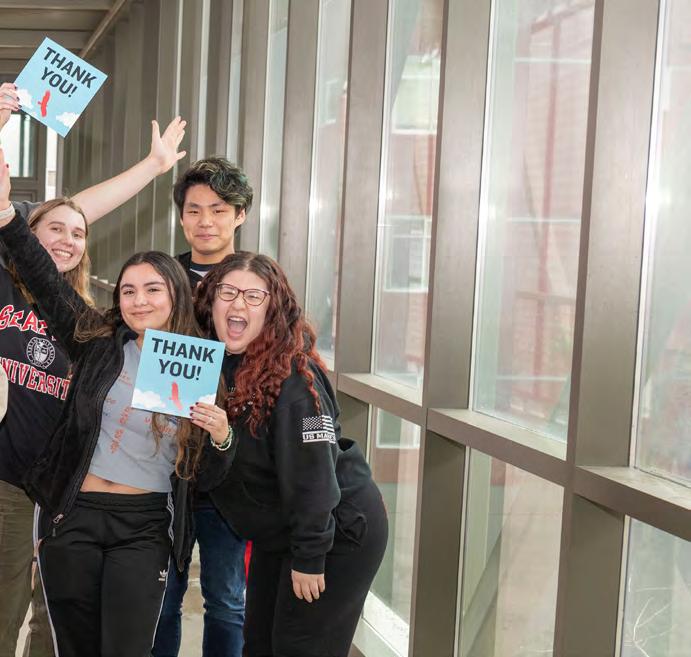

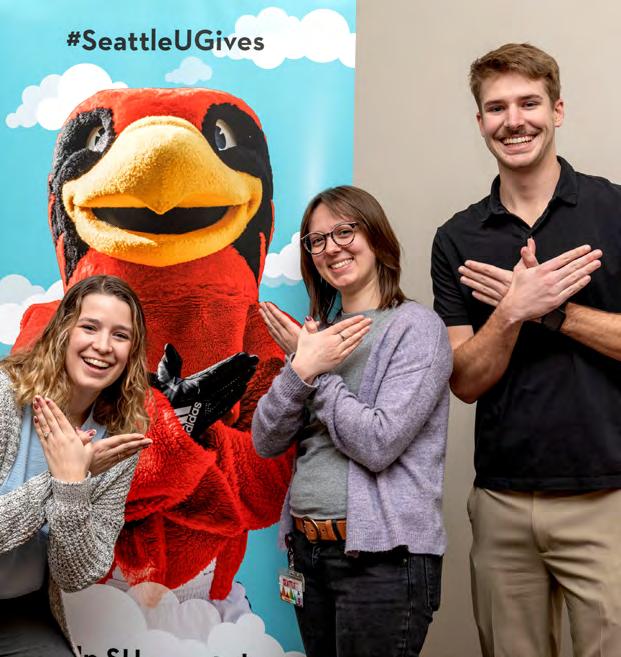
celebrated,” she says. “We help our students, educate our students. That’s SU’s mission, so why wouldn’t it be recognized?”
Political Science Professor Angelique M. Davis, JD, who is also director of the African and African American Studies Program, sees the new guidelines as not only recognizing the labor that goes into running the university and expanding what is recognized as scholarship, but also providing an additional path to advancement.
“I don’t want to make it ‘either/or,’ because it really is an ‘and,’” she says.
Before the changes, faculty were evaluated only for publishing or research or presenting at national conferences. They might be doing significant community-engaged research, administrative leadership, service and diversity and inclusion work, but these were not counted in the evaluation.
Business Law and Marketing Professor
Geneva “Eva” Sedgwick, JD, LLM, had followed the traditional academic promotional path until she changed directions in 2006, inspired by organizing a conference on biocolonialism called “Path of the Spirit: La Pena,” a combined event on biotechnology and Indigenous peoples’ rights and an evening celebration of Indigenous arts and music.
For Sedgwick, it opened a new kind of scholarship and she continued finding new ways to connect, including the production of a video presentation with Microsoft on ethics and law in data analytics. The video, on LinkedIn Learning’s platform, has had more than 30,000 participants globally. She also took on leadership roles across campus, including as former director of University Summer Programs and current director of the Albers MBA in Sport and Entertainment Management.
After 24 years devoted to Seattle University she leveled up to full professor last year, a process she says she would not have attempted under the previous guidelines. “I would not have applied because I would have assumed I would have failed,” she says.
Despite the work to build the campus into what it is today, and finding innovative ways to spread SU scholarship, which Sedgwick says is essential to restoring the public’s confidence in higher education, without recent publication she would have been denied the position she has now.
Sedgwick believes in the merits of traditional scholarship—she knows how a journal article that fleshes out the novel or obscure elements of a law can serve as a pillar of a major court decision that changes the world. But she sees other ways that scholars can affect the world and counting them toward their advancement aligns with the mission of Seattle University.
“How are we inspiring our students to have the courage to be everything that they can be for the world if we shut ourselves down, if we lock ourselves into a rigid model? How is that inspiring students to really think holistically about who they want to be in the world? It’s almost imperative that we honor what we say we do for them by what we do for each other,” she says.
And in many cases, excluding these types of campus-building work most impacted faculty members from underrepresented backgrounds already facing systemic barriers.
“Seattle University’s dedication to reevaluating these criteria has facilitated a more profound alignment with its mission,” says Colette Taylor, EdD, a professor and special assistant to the provost for strategic directions who has been instrumental in the work to reimagine the professoriate. “By recognizing and promoting faculty members more comprehensively, Seattle University has embarked on a transformative journey within its academic community.”
The goals captured in the new guidelines include a commitment to:
• Critically examine taken-for-granted ideals regarding faculty careers and what counts.
• Align SU’s educational mission with the realities of what is actually happening and recognize systems that are used to evaluate faculty.
• Identify the diversity of contributions that should be valued, welcomed and celebrated for what they are—necessary for the success, satisfaction and sustainability of the university.
• Restructure the promotion guidelines and provide mentoring so that SU will be able to effect the cultural transformation that is necessary to truly be a diverse campus.
Faculty like O’Brien are hopeful that these revised guidelines will serve as a national model for other colleges and universities looking to make similar progress in bringing equity and better student outcomes to their institutions.
Davis, the political science professor, works extensively with the National Center for Faculty Development and Diversity and often gets questions about Seattle University’s new guidelines from faculty at other institutions. It gives her the sense not only that higher education as a whole is recognizing the inequalities built into the traditional advancement system, but also there is a national movement of change underway with SU at the vanguard.
“A lot of campuses are moving toward this and we’re really serving as a catalyst to help get this started nationwide,” she says. “But just like any change, it’s going to take a long time and there’s some who will be on board and others who won’t.”
Philosophy Professor Paulette Kidder, PhD, who is in her 35th year at SU, applauds the willingness of the university to be a leader in making this change.
“I think having this policy for promotion says something about who we are as an institution, about what we value, what we are prepared to reward and recognize,” says Kidder. “I do think that we’ve had a tremendous increase in the diversity of our faculty and we want to stay on that path.”
—Lincoln Vander Veen contributed to this story.

1945
Lucretia H. Way (October 7, 2023)
1948
James L. Hawk (May 29, 2021)
Dorice L. Ramstead Wolfrom (September 8, 2023)
1949
Gerard F. Fitzmaurice (September 9, 2023)
1951
Dolores M. Hagan (July 18, 2023)
Hugh R. McGough (December 15, 2023)
Bernice E. Tangney (November 10, 2023)
1952
Barbara L. Bisom (October 24, 2023)
William T. Cavender (October 9, 2023)
Claire D. Crocker (July 31, 2023)
John E. Galus (October 23, 2023)
Joyce M. Harrington (August 31, 2023)
1953
Robert C. Kelly (September 20, 2023)
1954
Rodney L. Dennison (August 29, 2023)
Joanne M. Kurtz (September 30, 2023)
1956
Donna A. Chan (September 24, 2023)
Thomas P. Holt (September 8, 2023)
James A. Lambo (October 23, 2023)
1957
Roy W. Gorud (August 22, 2023)
1991

1958
William B. Cammarano (September 21, 2023)
Rosaleen B. Finnegan (September 8, 2023)
Mauri Oaksmith (January 14, 2021)
1959
Joan Kavanagh Zehnder (August 20, 2021)
1960
Harold E. Abegglen (November 20, 2023)
1962
Agnes B. Lew (September 11, 2023)
1963
John F. Lybyer (September 1, 2023)
1965
James M. Haley (November 8, 2023)
Rose Mary Lyons (August 19, 2023)
Mary L. Moorhouse (October 4, 2023)
Nevada L. Sample (July 23, 2023)
1966
John J. Borelli (November 20, 2023)
Ralph R. Heyward (September 13, 2023)
Marie L. Legaz Whitley (October 24, 2023)
Margaret A. Parry (September 4, 2023)
1967
Michael Acosta (September 3, 2023)
Gene L. Cote (November 28, 2023)
1969
Jill Farley (July 9, 2023)
1970
Dale A. Johnson (October 30, 2023)
1971
Paul F. Folino (October 14, 2023)
Patricia A. Macier (September 15, 2023)
Larry C. Wise (August 22, 2023)
1974
Gregory J. Berry (August 19, 2023)
Helen T. Brennan (July 20, 2023)
Carrie M. Schindler (August 22, 2023)
Susan C. Valdez (November 27, 2023)
1975
Dolores J. Bray (July 22, 2023)
1977
Anthony T. Long (July 6, 2023)
John J. Valko (August 9, 2023)
1979
Alan S. Paja (September 11, 2023)
1980
Havalock A. Jones (October 27, 2023)
1981
Anita C. Demonbrun (July 30, 2023)
1985
Letha Owens (January 14, 2024)
1986
Margaret T. Muller (October 17, 2023)
1989
Mary P. Smith (August 15, 2023)
1990
Marian McNally (October 28, 2023)
Margaret E. Ransley (August 22, 2023)
1992
Dawn B. Moore (September 3, 2023)
Daniel C. Ursino (July 30, 2023)

National Judicial College President & CEO Benes Z. Aldana received the American Bar Association’s (ABA) Spirit of Excellence Award during the ABA’s midyear meeting in Louisville, Kentucky. According to the ABA, the Spirit of Excellence Awards celebrate the efforts and accomplishments of lawyers who work to promote a more racially and ethnically diverse legal profession. Awards are presented to lawyers who excel in their professional settings, who personify excellence on the national and international level and who have demonstrated a commitment to racial and ethnic diversity in the legal profession.
1993
Lynda M. Lovely-Wright (September 30, 2023)
1996
Laura M. Rehrmann (July 19, 2023)
Carol H. Van Buren (August 4, 2023)
1997
Steve Barlow (August 26, 2023)
James F. Zurcher (October 31, 2023)
1998
Paul G. Bullard (September 4, 2023)
2001
Thomas E. Gates (August 2023)
2008
Davina T. Carter (August 20, 2023)
2011
Mathew H. Simonto (October 6, 2023)
2015
Shahilene E. Dillon (August 8, 2023)
Mycole M. Doi (August 25, 2023)
2019
Lucas R. Riley (September 20, 2023)
Kathy Collins (January 19, 2024) (Staff)
Katherine A. Iverson (November 15, 2023) (Staff)
Dr. O. David Jackson, ’08 LEMBA (Faculty)
Seattle University honors the memory of those in our community who we’ve lost. Send notice of a loved one’s passing, including an online or print obituary if available, to tinap@seattleu.edu
Two SU alums have joined the Seattle office of law firm Schwabe. Laura Lemire, ’09, is part of the firm’s technology industry group and Karleen Scharer, ’14, will be working with the products, manufacturing and retail industry group. Both are experienced litigators in areas from privacy and cybersecurity law to liability and commercial litigation.
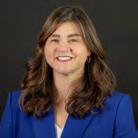

Renowned Seattle artists
Dennis Evans and Nancy Mee gift Seattle University their considerable personal art collection.
by tina potterf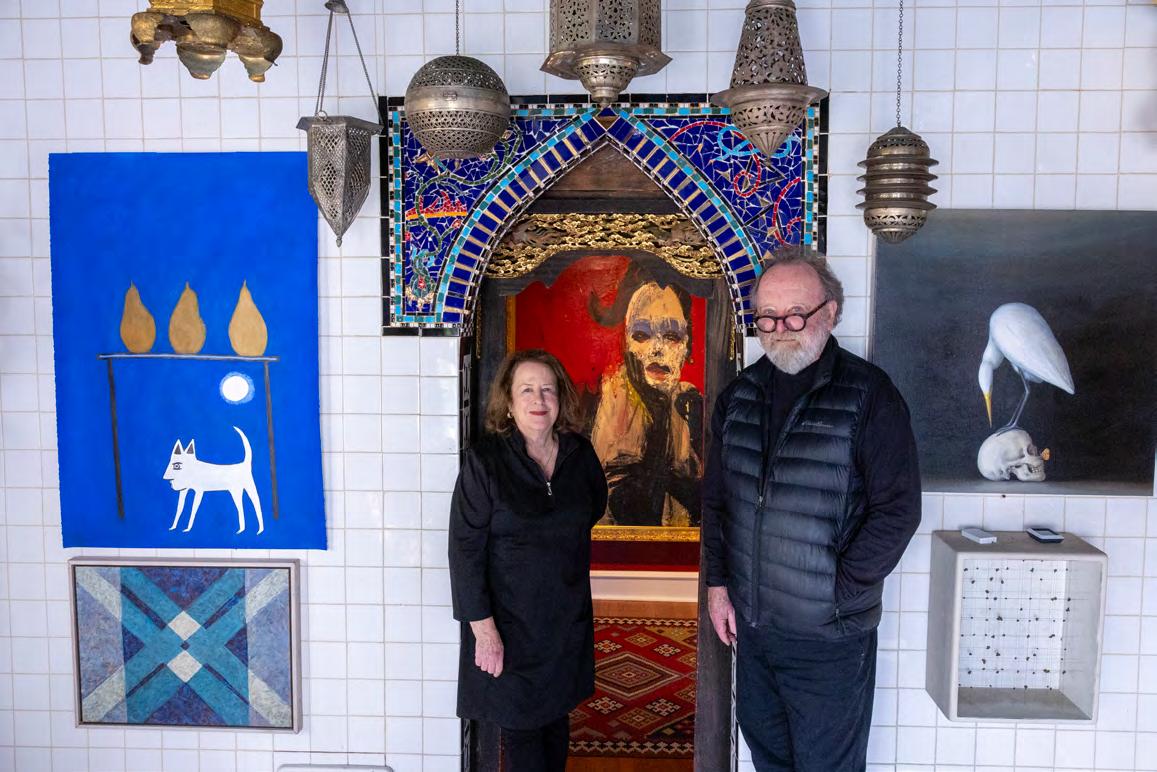
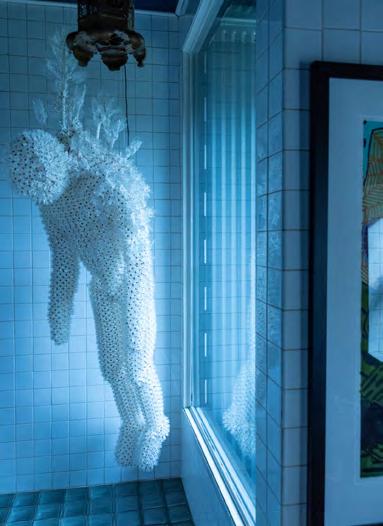

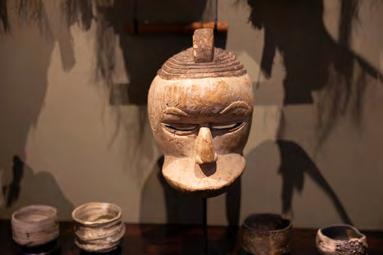

Seattle University is home to an impressive permanent art collection—from modern and contemporary art to large-scale sculptural pieces, paintings and masks to mixed media works—that is awe-inspiring. Throughout campus, from buildings—including the Chapel of St. Ignatius, which itself is highly regarded as a work of architectural artistry—to green spaces, art is all around us.
There are works by Jacob Lawrence, David Teichner, Roger Shimamura, Steve Heilmer, Amanda Manitac, Dale Chihuly and Hiawatha D and Northwest Coast and First Nations artists Preston Singletary, Calvin Hunt, Susan Point and Andrea Wilbur-Sigo, among many others. Striking sculptural pieces erected outside the Lemieux Library and McGoldrick Learning Commons are conversation starters and the calming and majestic Centennial Fountain, created by George Tsutakawa, is a bold centerpiece of the Quad. SU’s art collection reflects its Jesuit and Catholic heritage, ethos and broad cultural values with themes touching on social and racial justice, technology, innovation and the intersection of science and the arts.
Among the works that enrich SU’s arts scape are commissioned pieces by acclaimed Seattle-based artists Dennis Evans and Nancy Mee. Evans’ The Cosmic Code: Ten Cantos, in the Sinegal Center for Science and Innovation, evokes the evolution of the universe from the Big Bang. Mee’s monumental sculpture Themis (Justice) awaits students, faculty and guests at its home, fittingly, in the School of Law. The couples’ artistic collaboration representing The Nine Muses (poetry, comedy, sacred song, love lyrics, music, dance, tragedy, history and astronomy) resides on the sixth floor of the library.
And now, thanks to the generosity of Mee and Evans, SU’s permanent collection is growing exponentially. The husband-andwife duo are gifting their personal art collection—more than 250 pieces—to Seattle University.
As part of the gift the artworks and objects will be displayed in appropriate areas and departments across campus and be used in an educational context such as to enhance a course or program that draws from themes or features an artist whose work is included in the collection.
Roughly 150 of the pieces are Contemporary Northwest Art, with 85 different artists represented, many contributing multiple works. The artists include Alden Mason, Steve Jensen, Guy Anderson, Joseph Goldberg, Gene Gentry McMahon, Julie Speidel, Gloria DeArcangelis, Michael Spafford, Spike Mafford and Mary Ann Peters.
Along with the collection there will be a significant endowment to provide for the care of the art and to enhance academic opportunities in visual art, art history, curatorship and potentially a chair for the study of Northwest art.
“We’re so grateful to you both for your gift to Seattle University, your gift of art and your gift for the curation of art,” says President
Eduardo Peñalver. “Art is a really important part of the Jesuit education model. If you go through campus you are surrounded by art wherever you go, including your art.”
The idea for this gift first germinated when Evans visited campus. A few years ago, he was contacted by Josef Venker, S.J., curator of SU’s permanent art collection, to do a commissioned work for the new Sinegal Center. While on campus Evans toured the existing art collection and was impressed with many of the works and how they were displayed.
“In the course of that, I said (to Josef) that we were struggling with what to do with all of our art. Josef jokingly said, ‘Well … Seattle U would love to have it.’ He then said, ‘Why wouldn’t you just give it to a museum?’ I explained that museums cherry pick a collection and they deaccession a lot of it and then put it in storage,” Evans explains. “And museums change directors and with that the vision changes. Josef looked at me and said, ‘You don’t have to worry about that with the Jesuits. We have been around for 500 years and we change very slowly.’ Though he was joking, that profoundly impacted me. I love what the Jesuits are, who they are, what they stand for.”
With this gift, not only is it assured that the collection will stay intact, per the artists’ wishes, but also that it will be showcased in an environment where it can be appreciated by many people who might not otherwise be able to experience art like this.
“One of the great things about this gift is these pieces will be on the walls on all the buildings. Generations are going to look at them, learn from them. It’s a teaching tool as well as a safeguard of the art,” says Evans.
“Other institutions or galleries don’t necessarily have the audience (of Seattle University) that we know on a daily basis will see this work, that people of all walks of life will be able to view it. That was the impetus to keep it together,” adds Mee. “The art will keep living inside a community that birthed it, lived it. … Our true value in this collection is that it encompasses 50 years of creative making in our region and celebrates local artists.”
The vastness and eclectic nature of the collection is a celebration of art—the paintings, mixed media and sculptural pieces created by Evans and Mee alongside pieces they’ve collected over the years, including Indigenous masks from around the world. These pieces both complement and fit well into the university’s existing permanent collection.
What’s their advice for students and others who aspire to be artists? “Get a day job,” says Mee, with a smile.
“I tell kids who know they want to be artists,” and there’s no dissuading them, that “you got to have the will of steel, and a heart as a big as a lion, to be an artist,” says Evans. “It’s a tough business, financially, spiritually, ego-wise. It is devastating but it’s the most fabulous job you can have. I would never trade a day of my life.”
Check out this video with the artists, discussing the meaning behind the gift, connection to the Jesuits and more.
